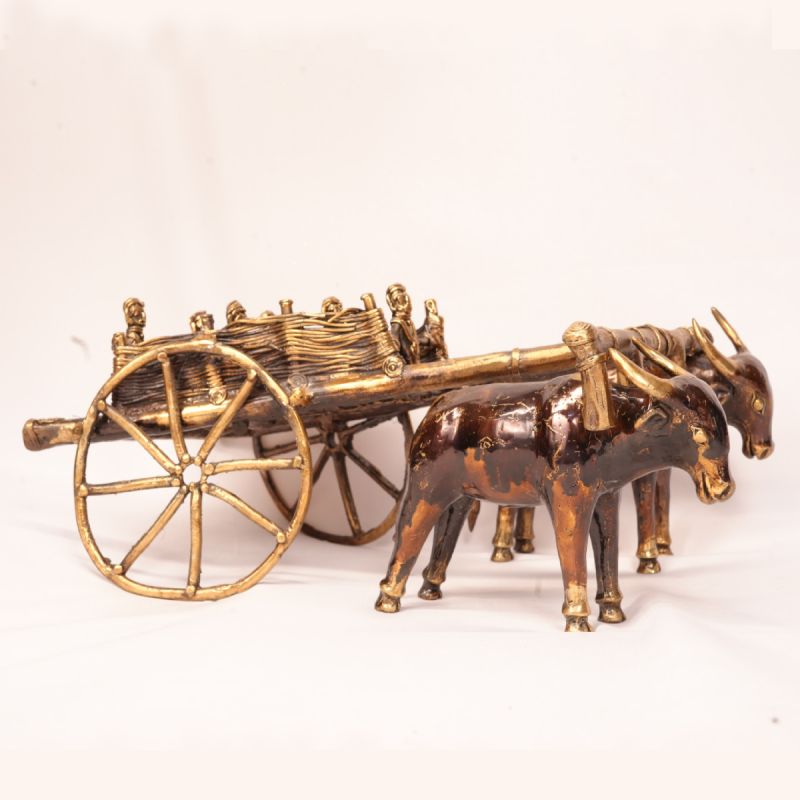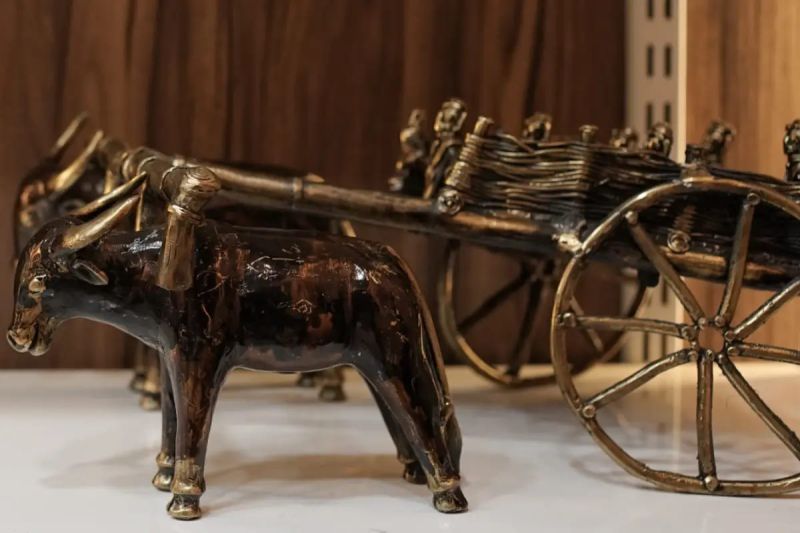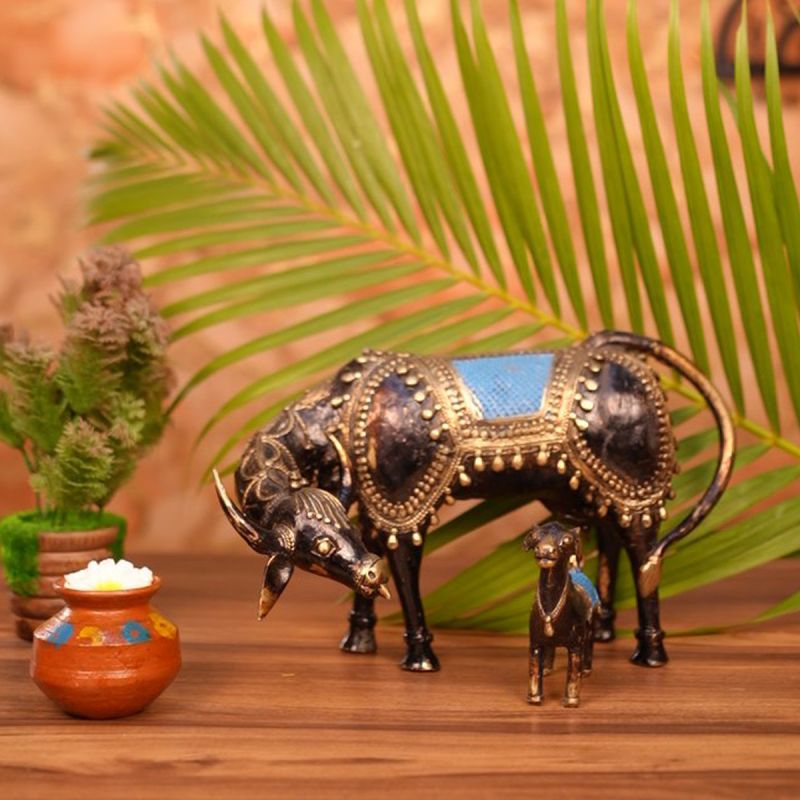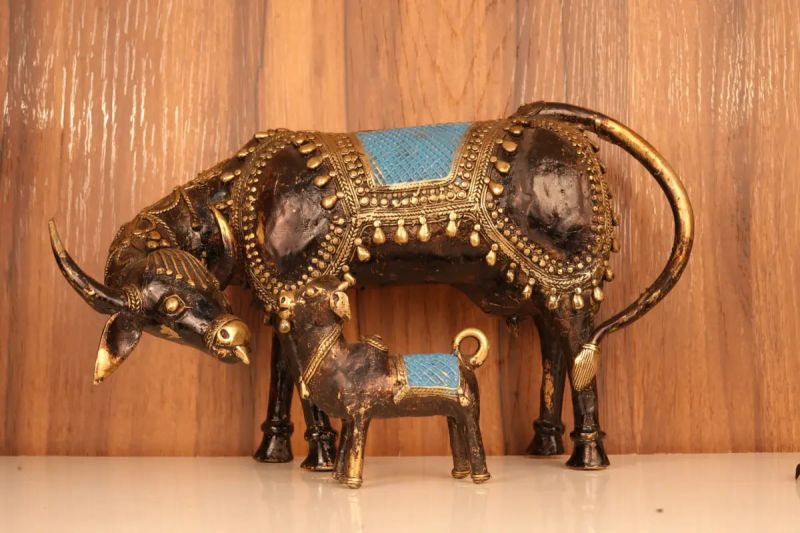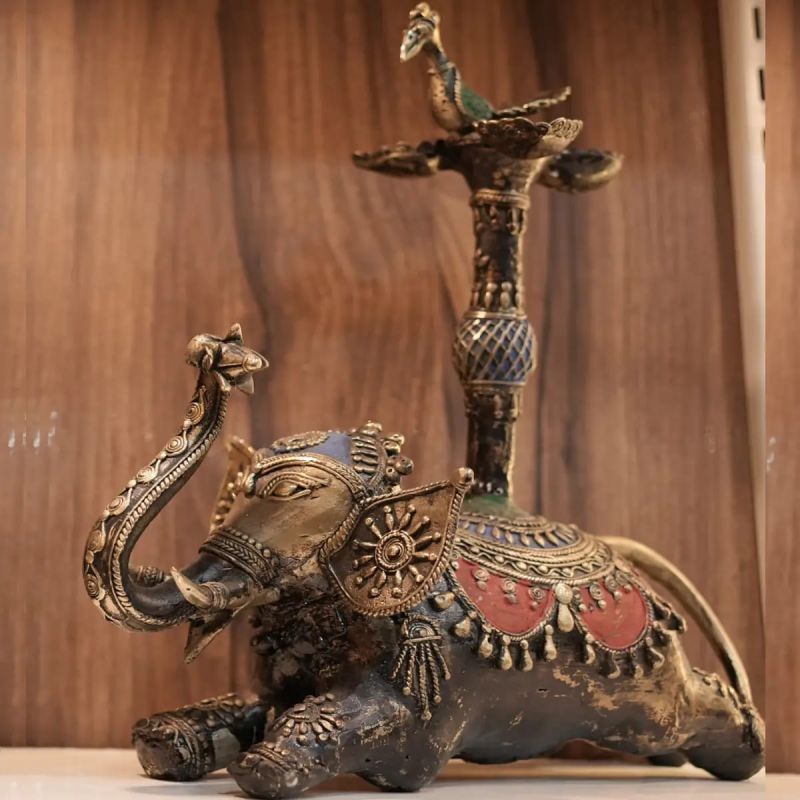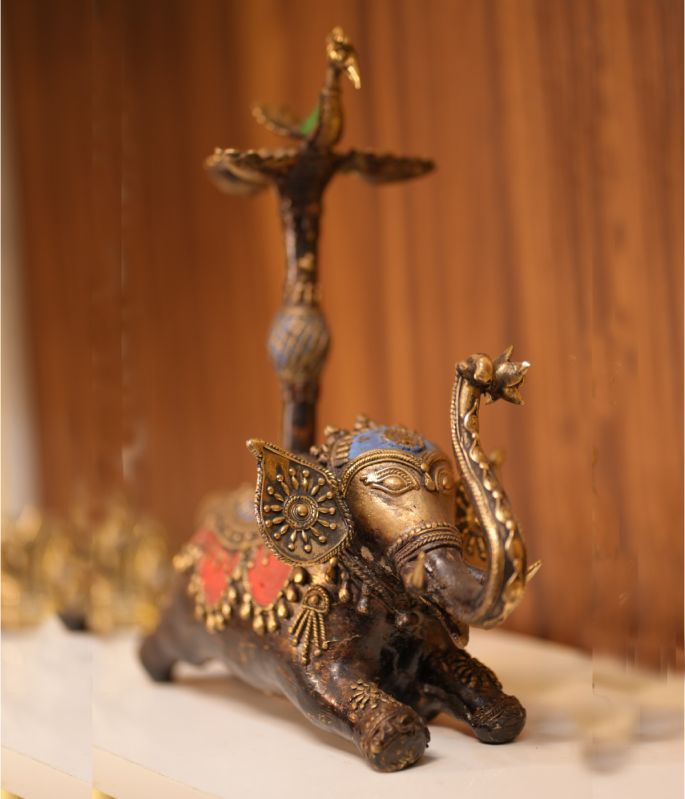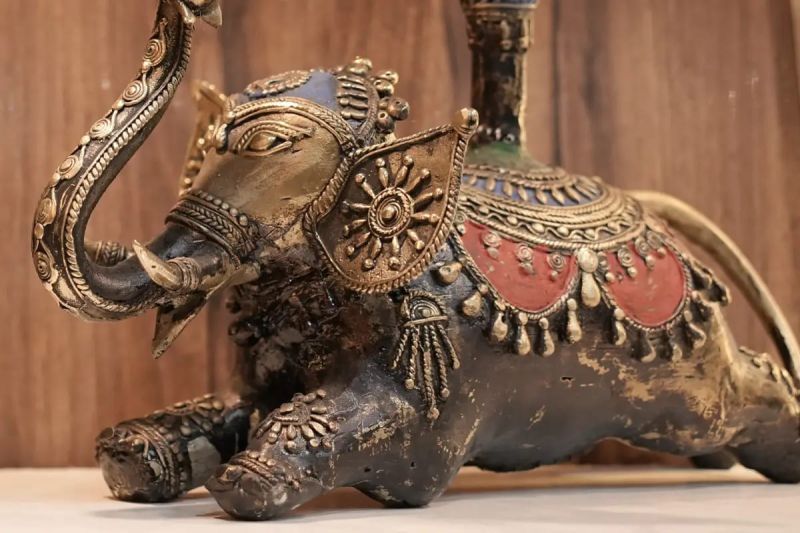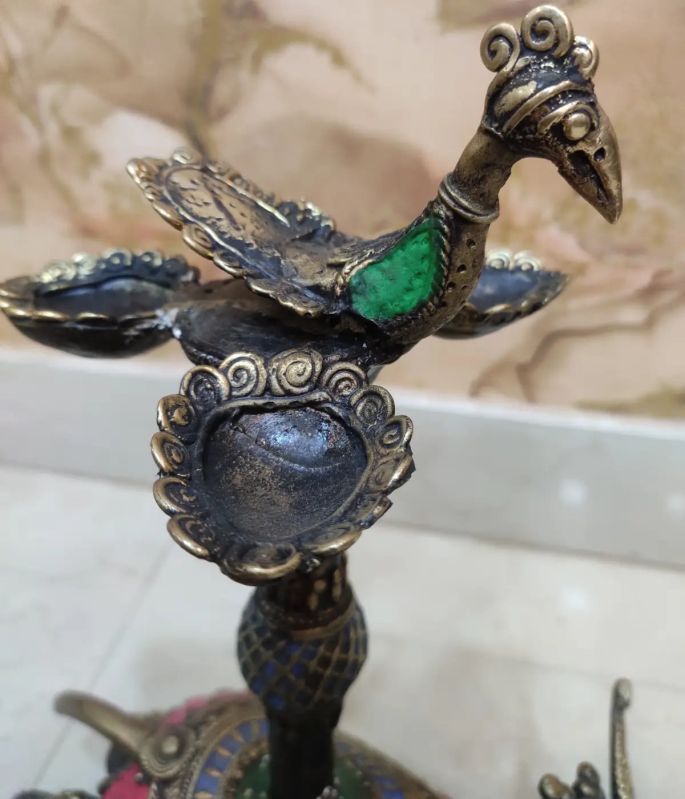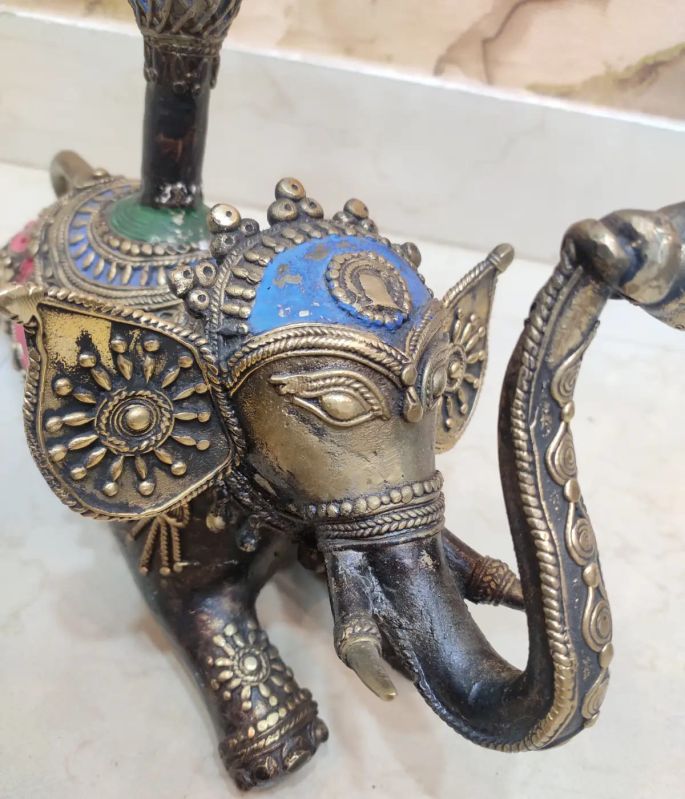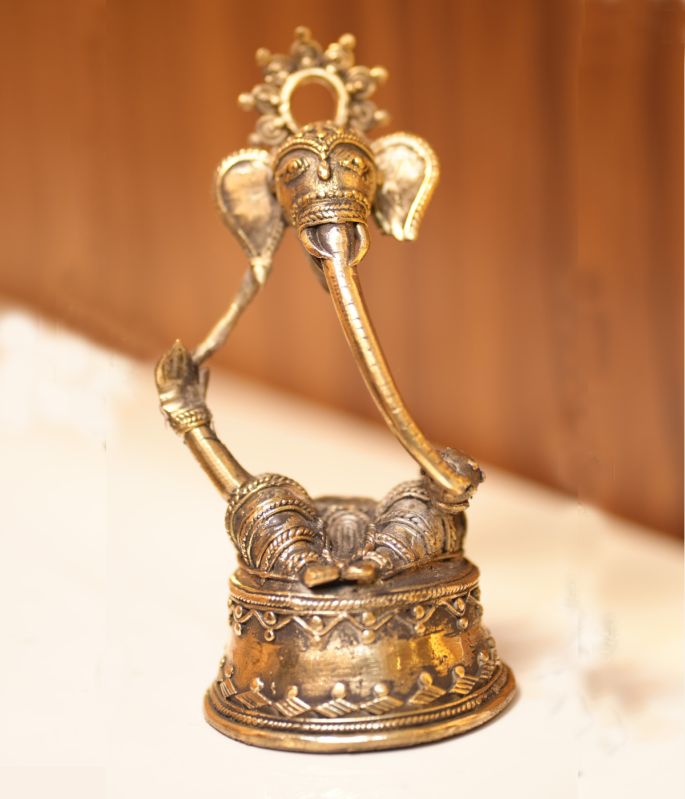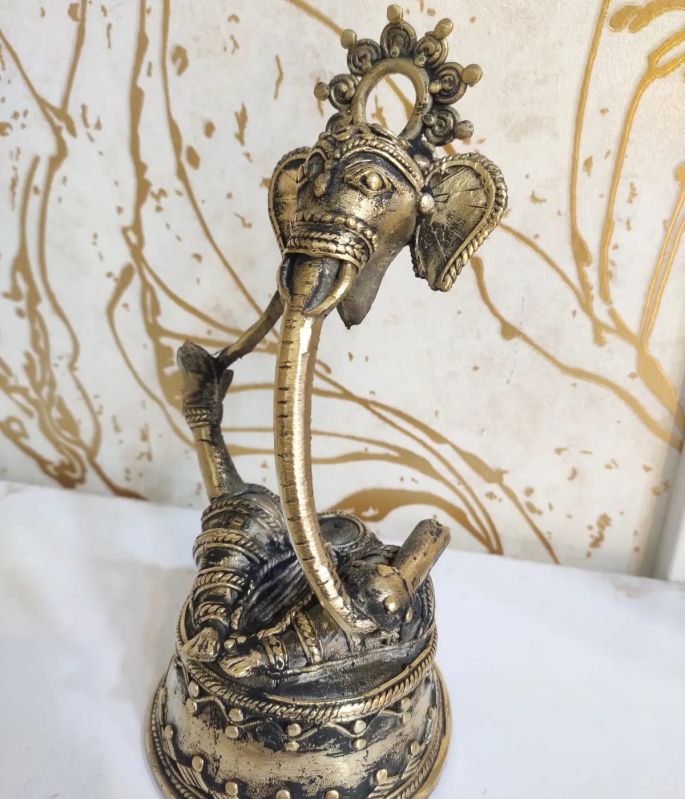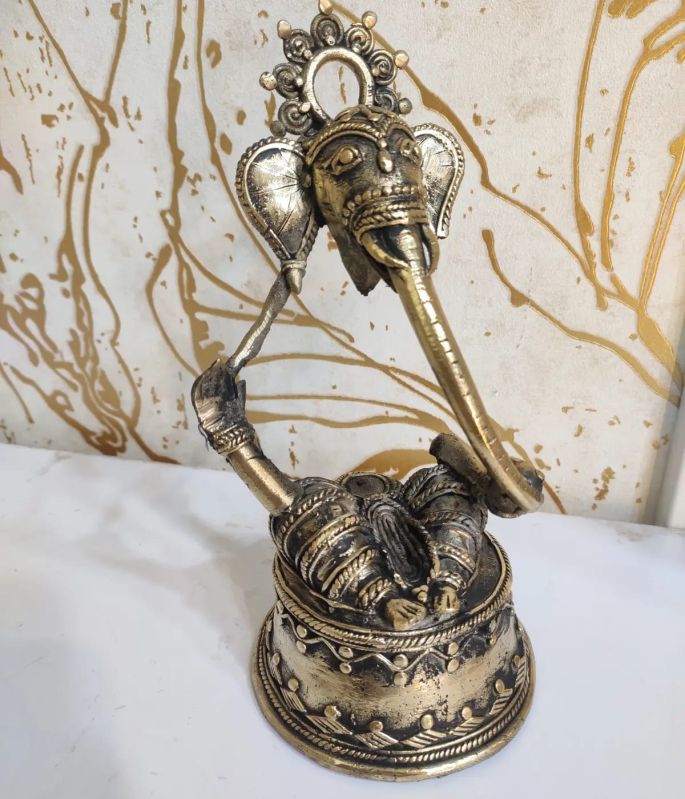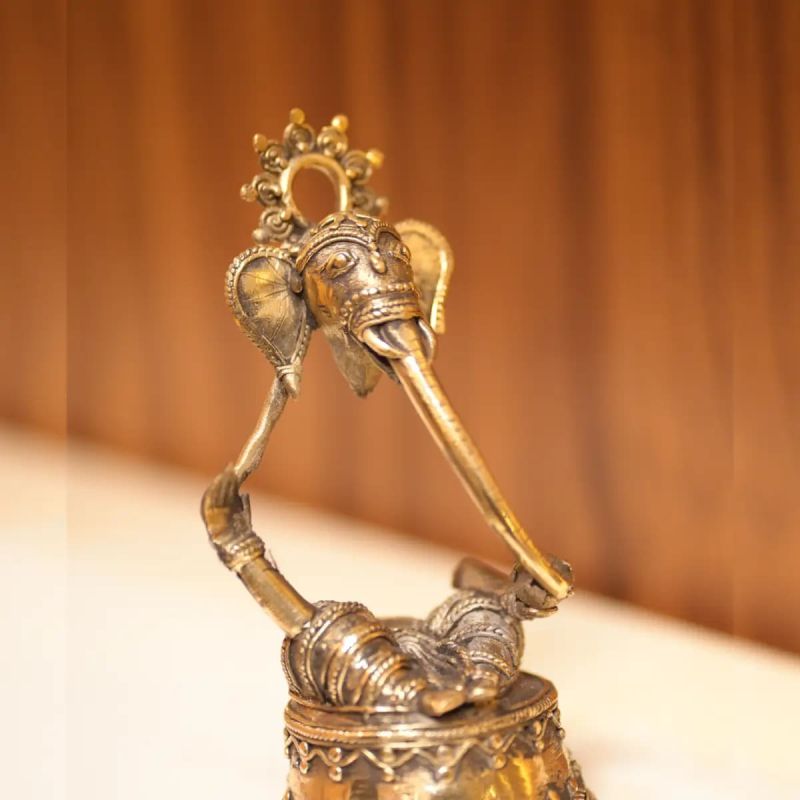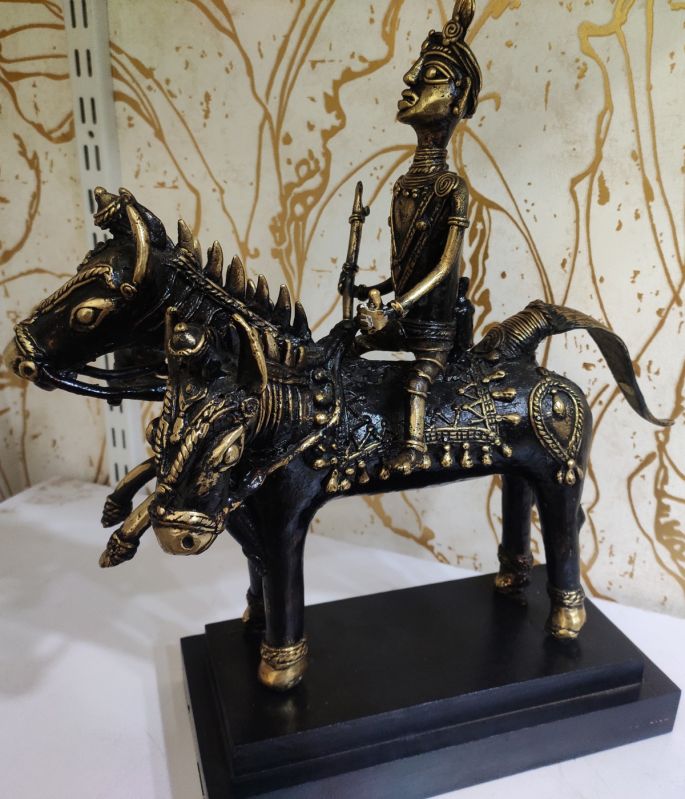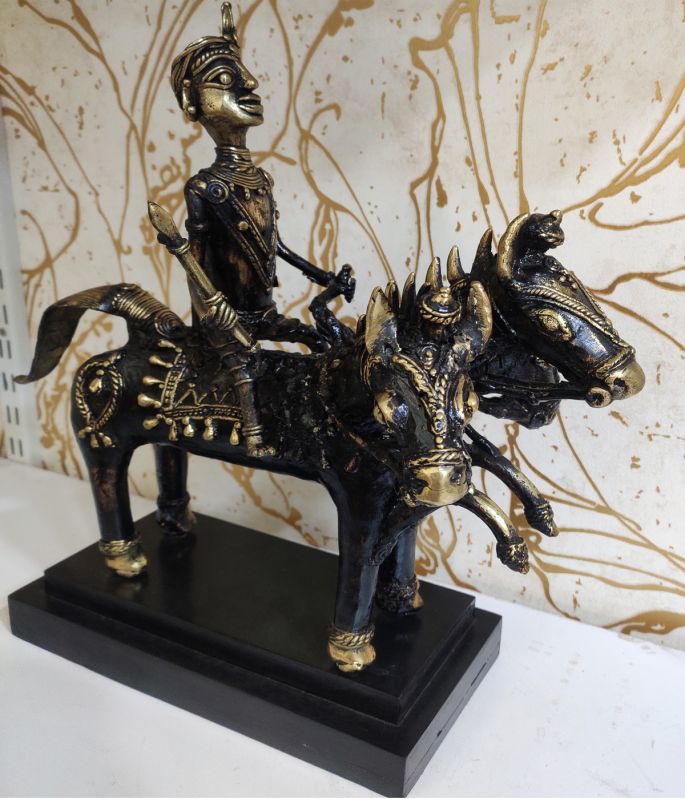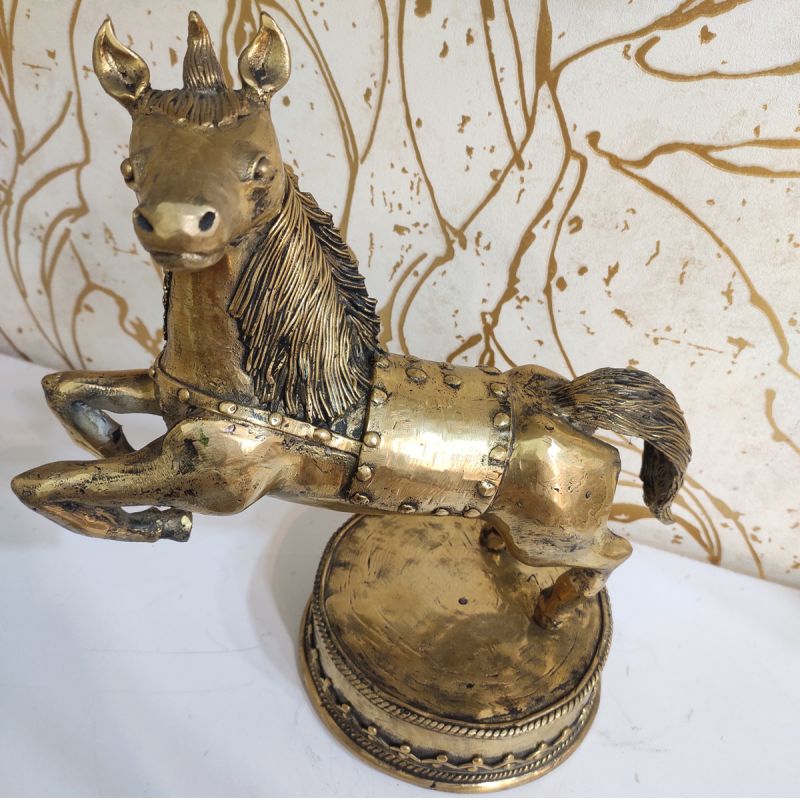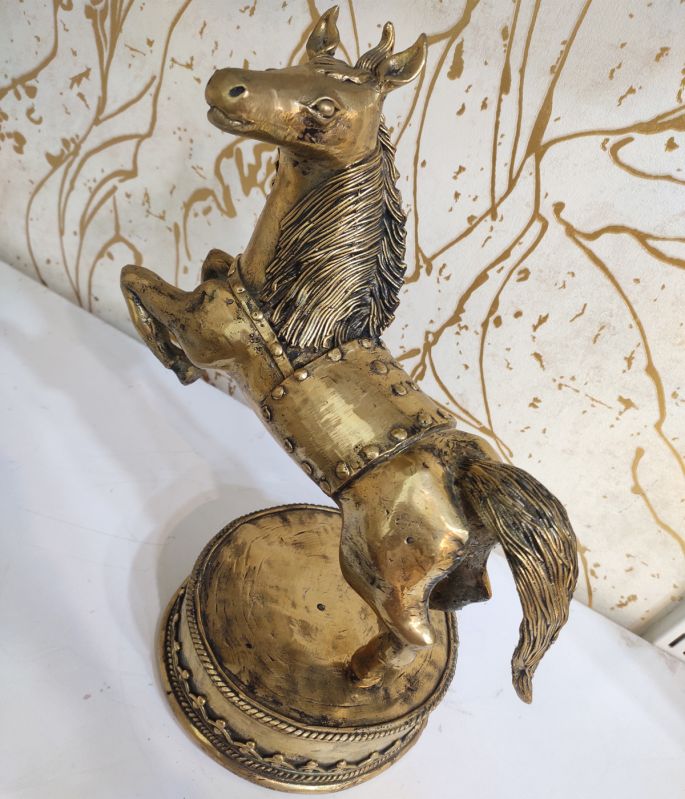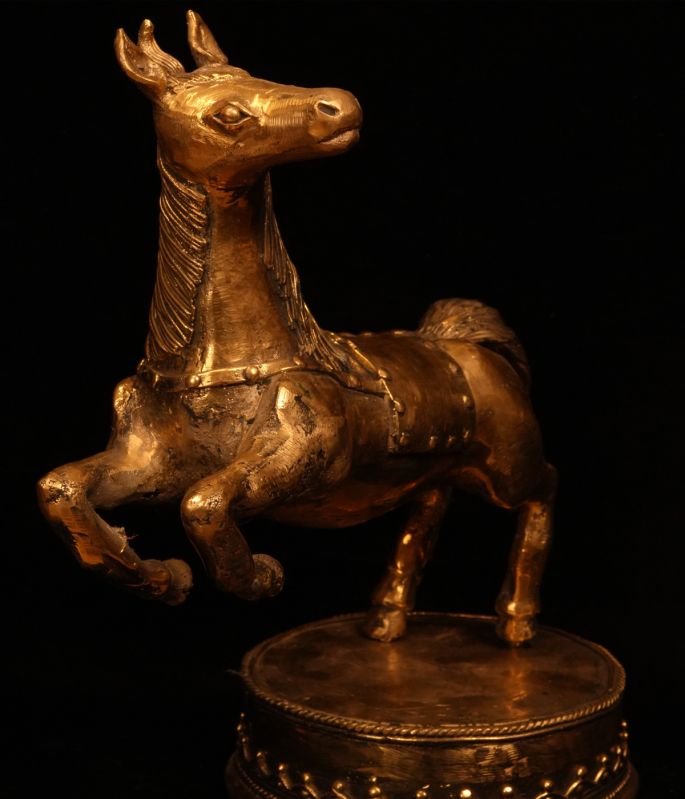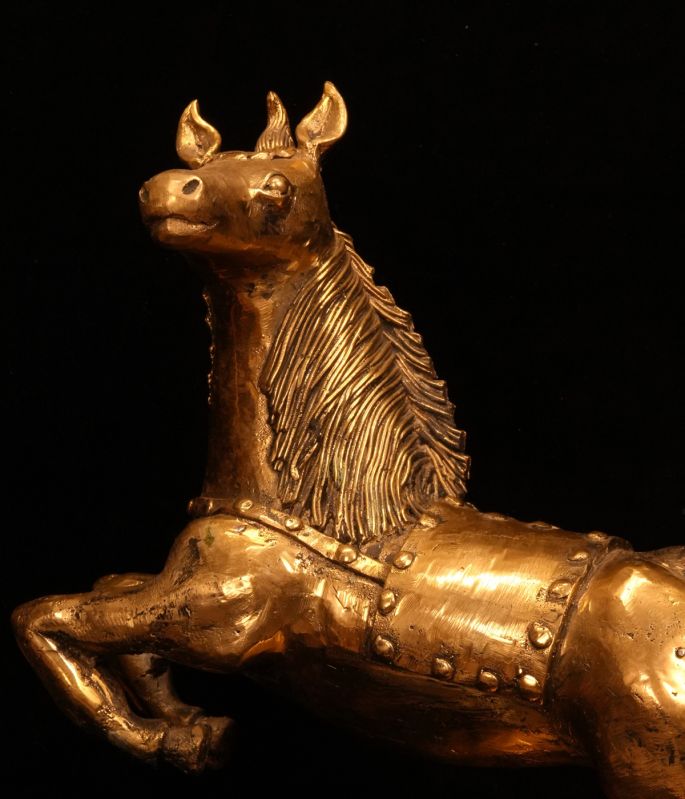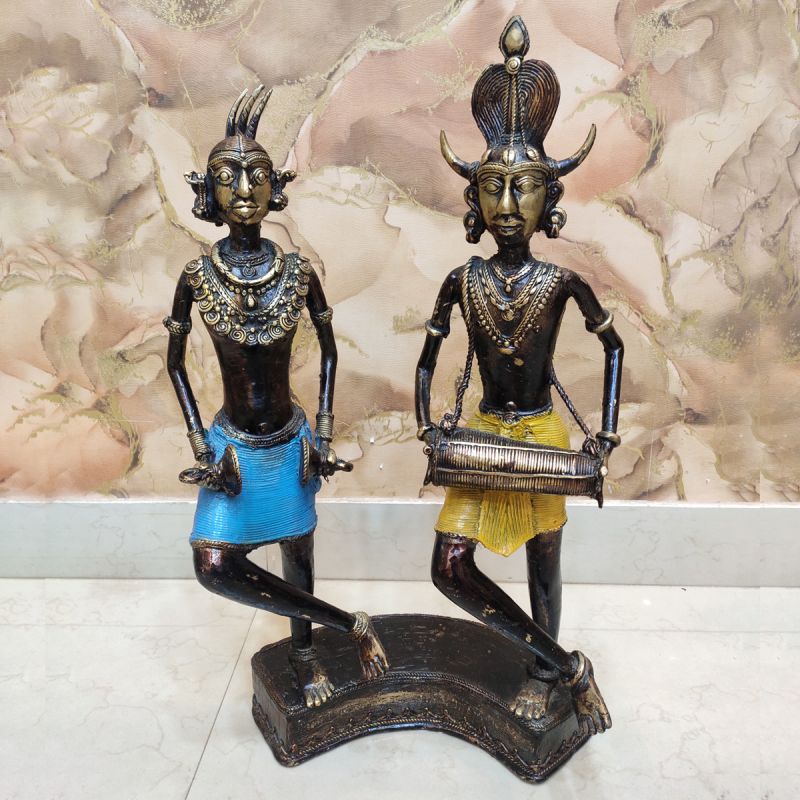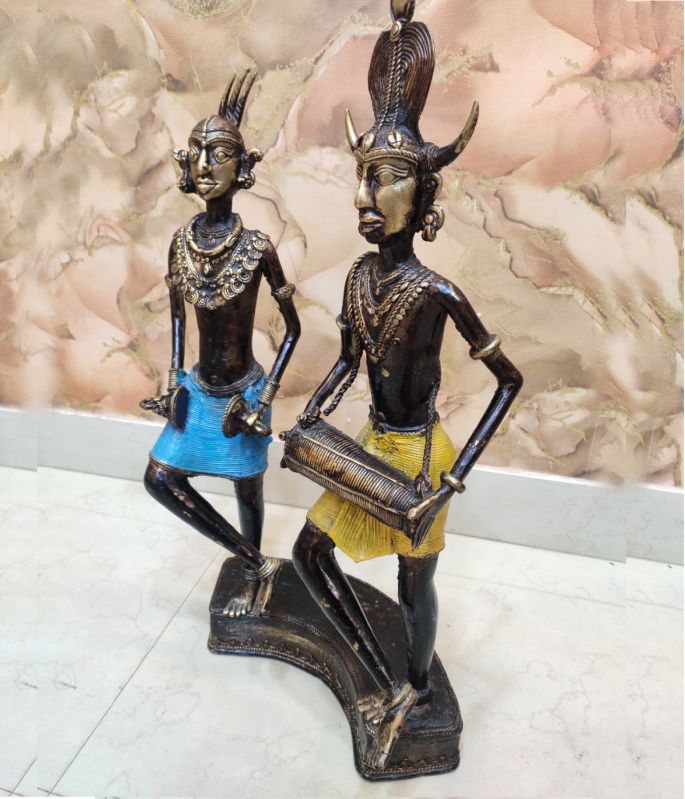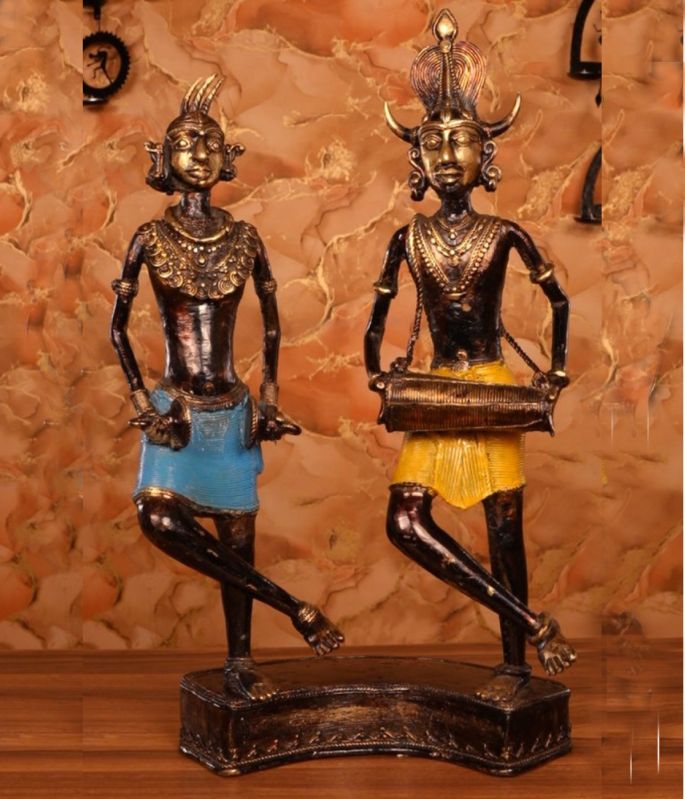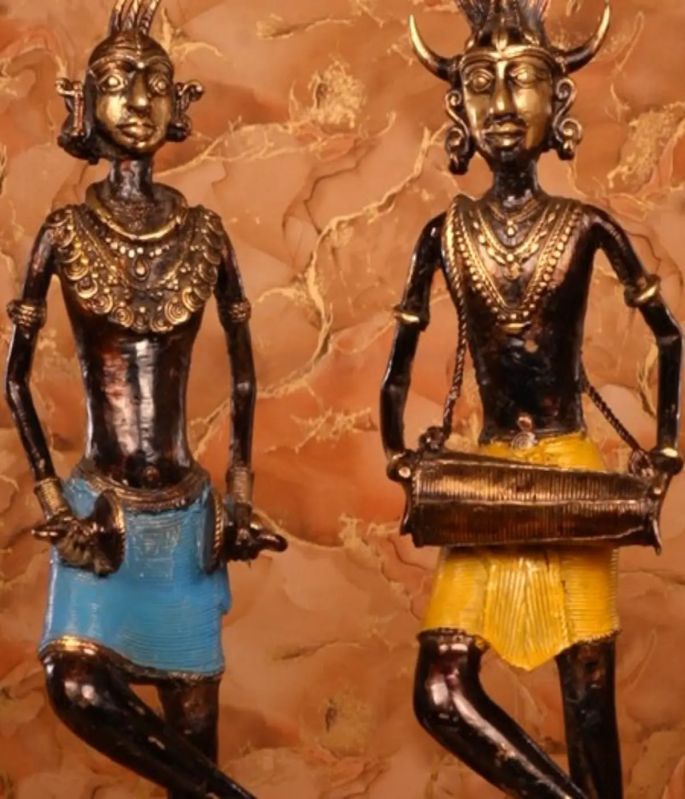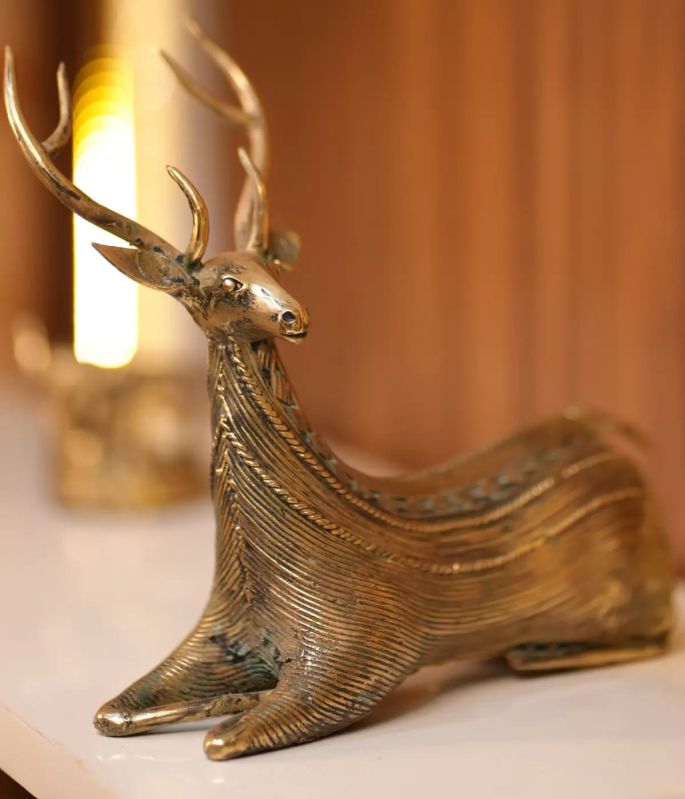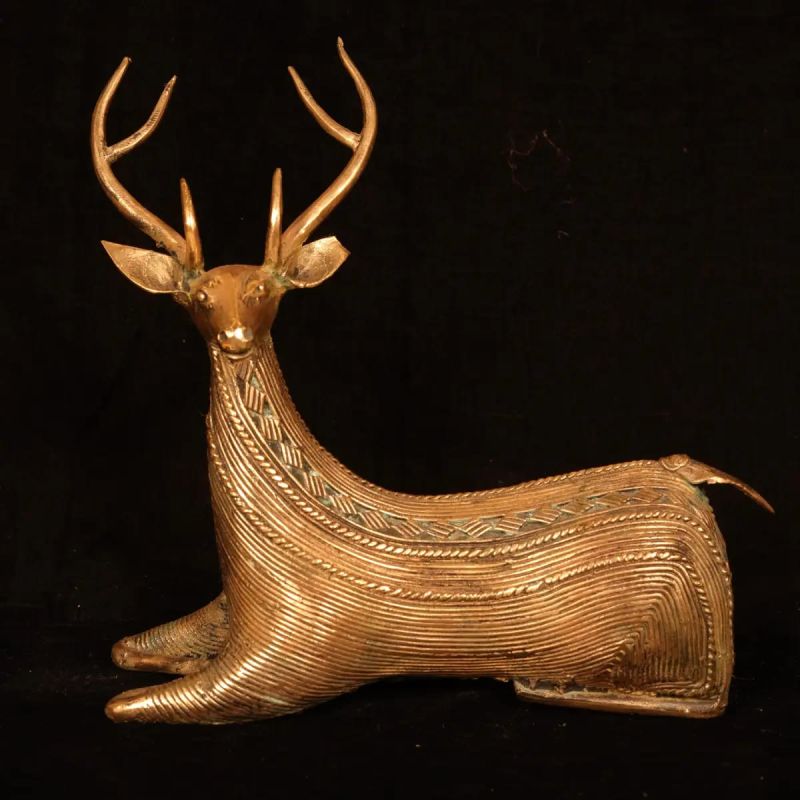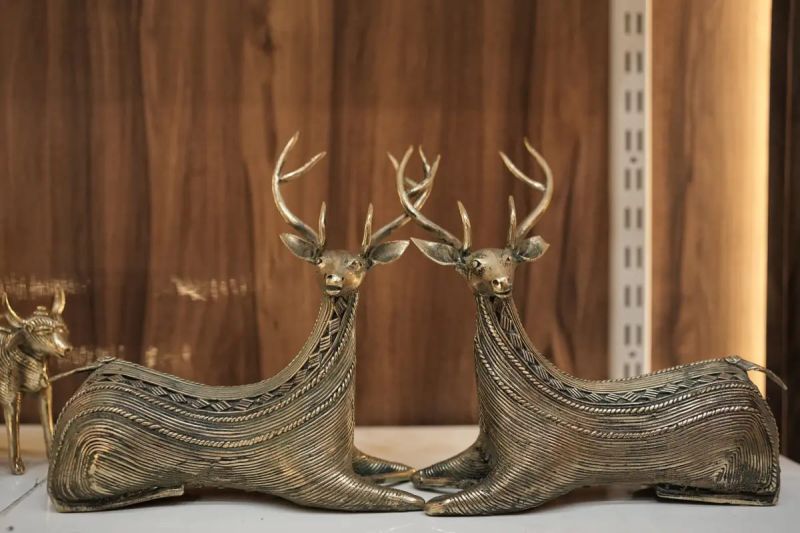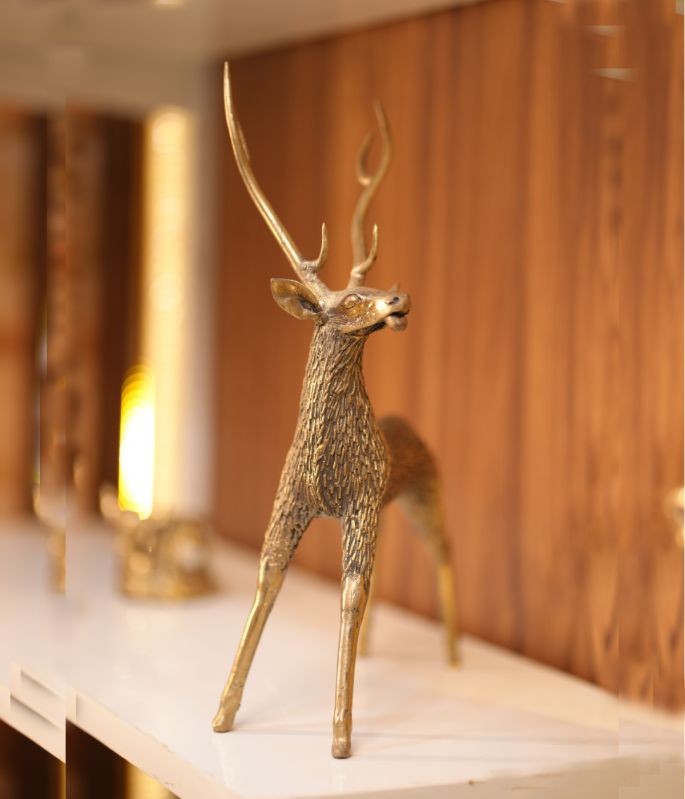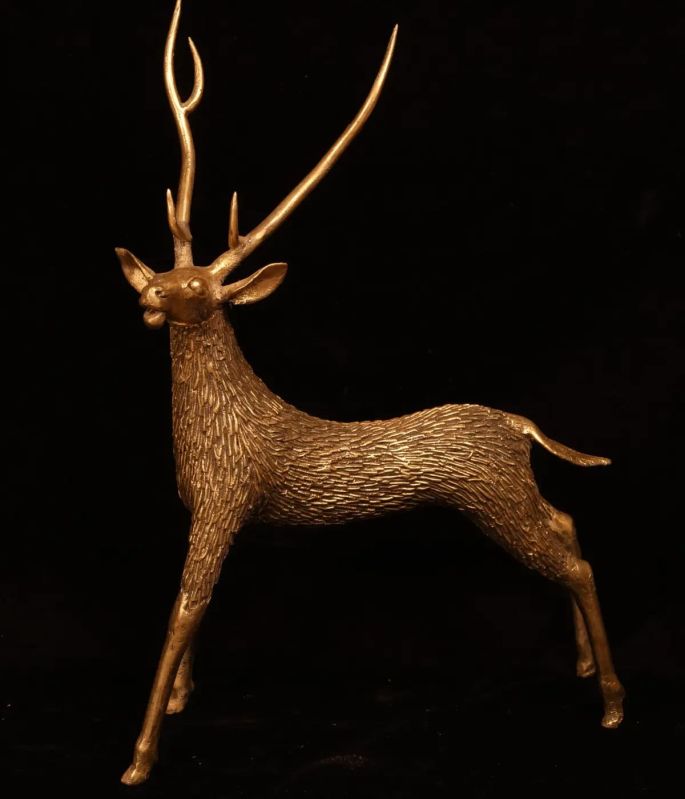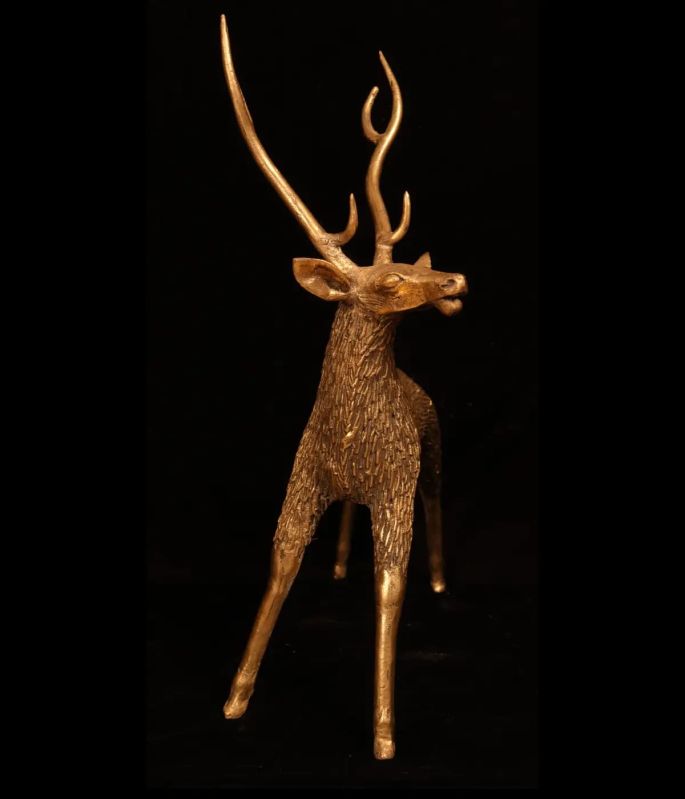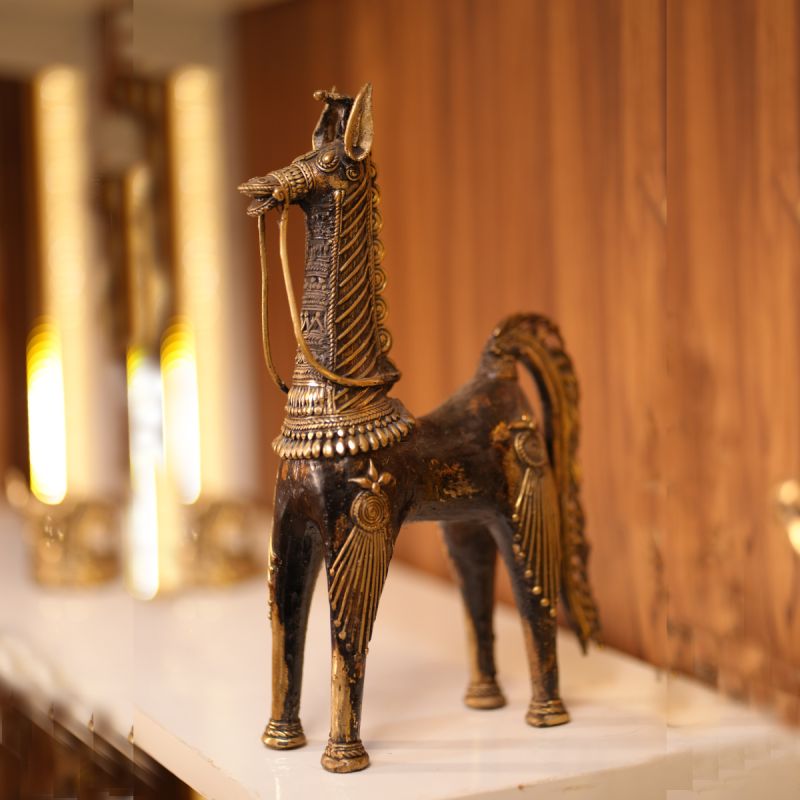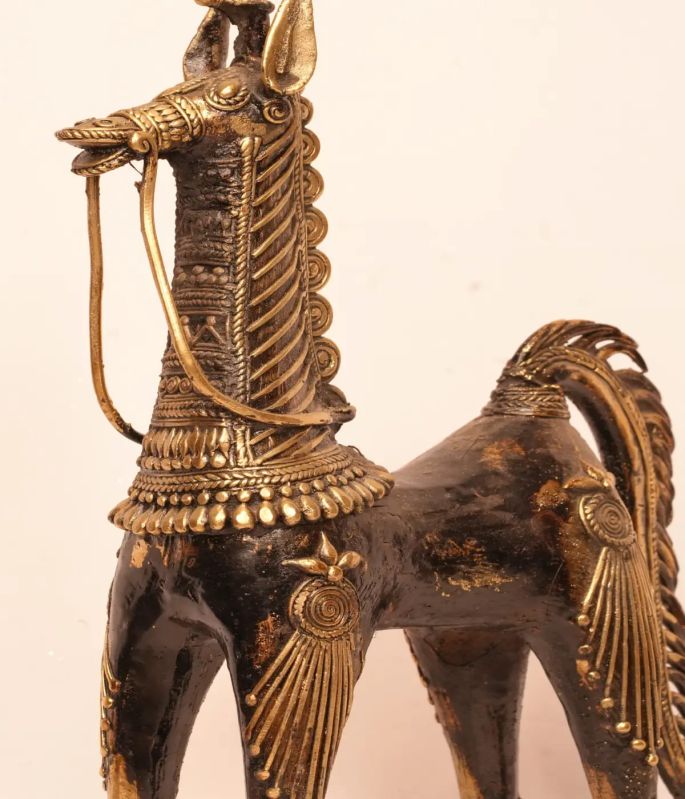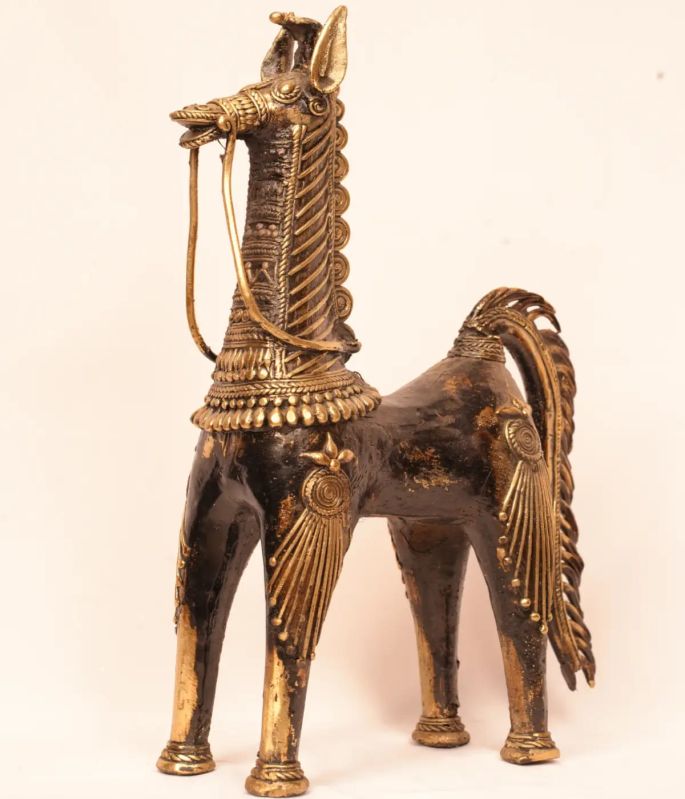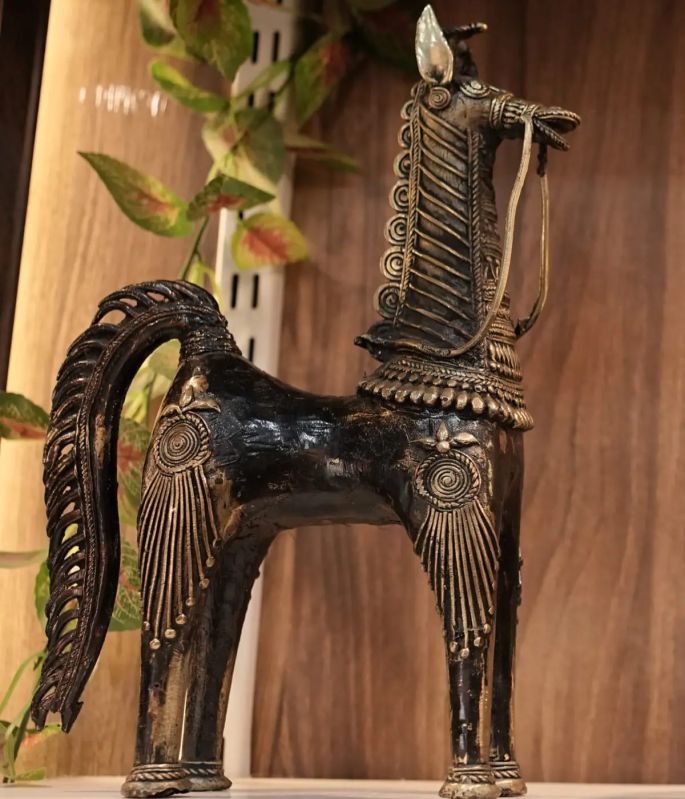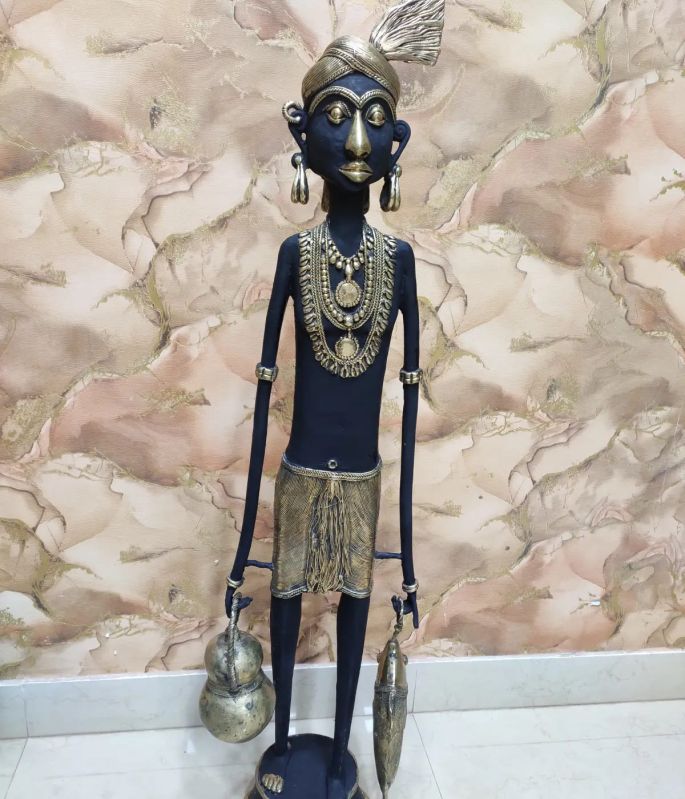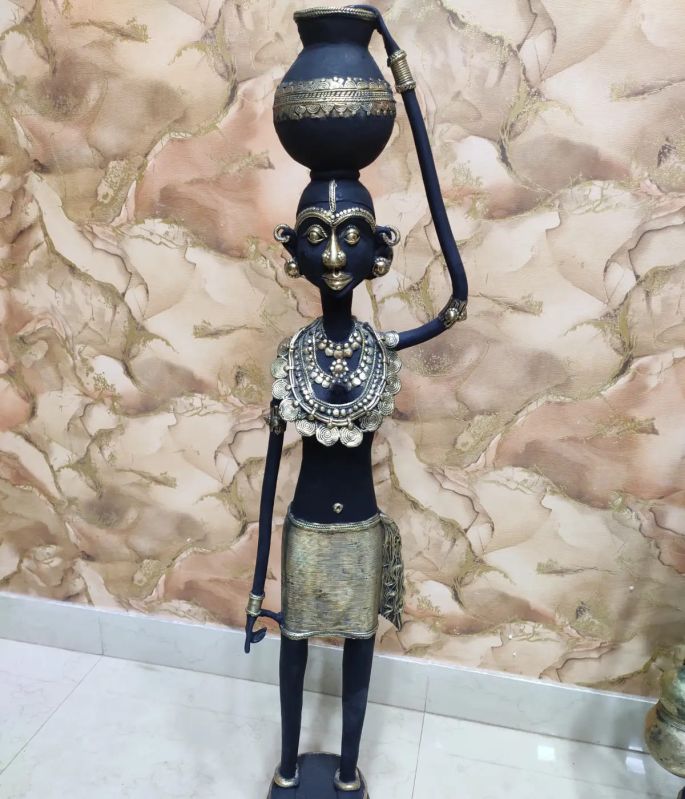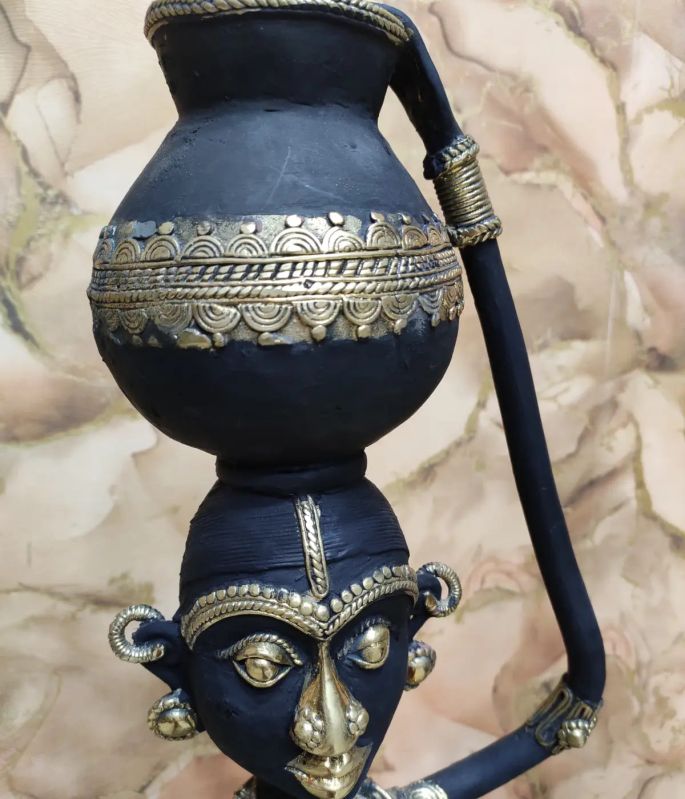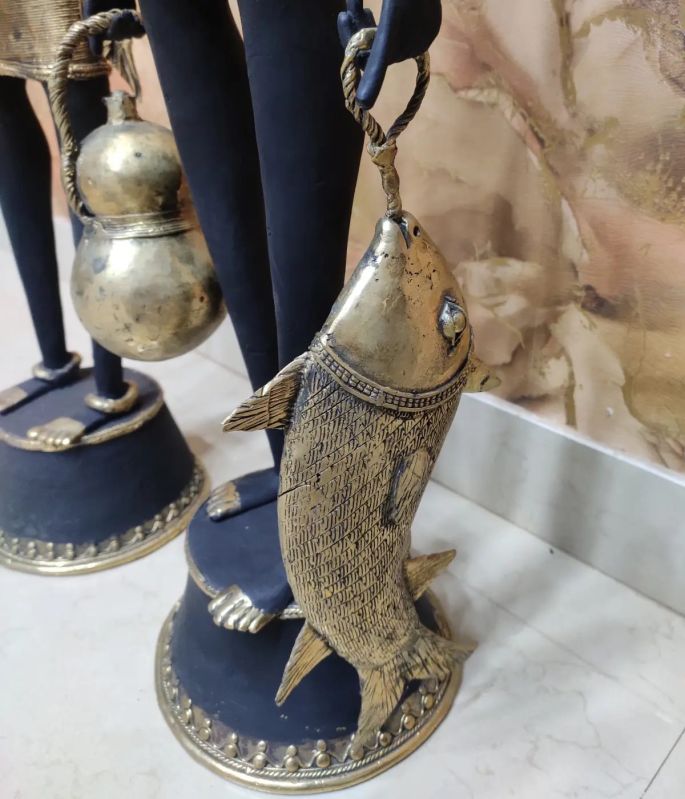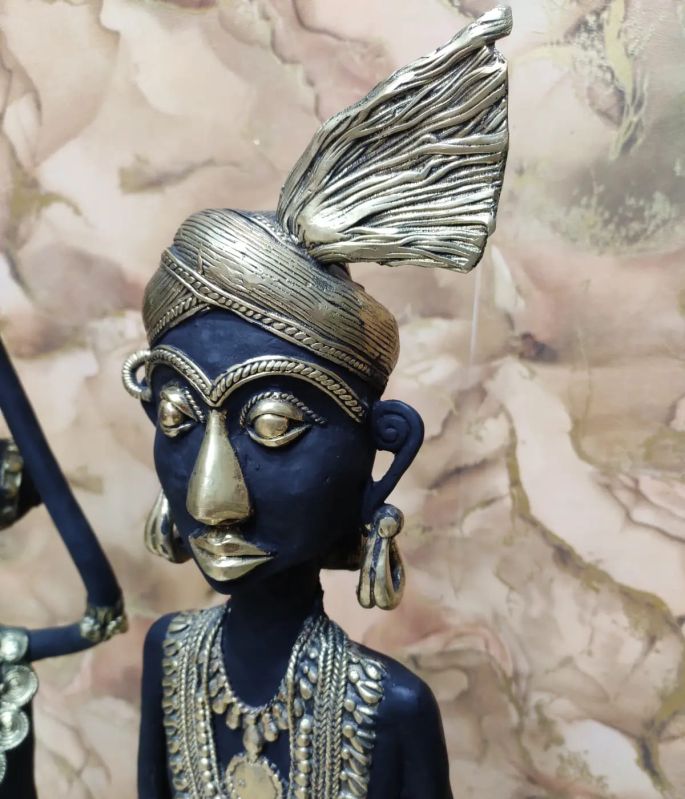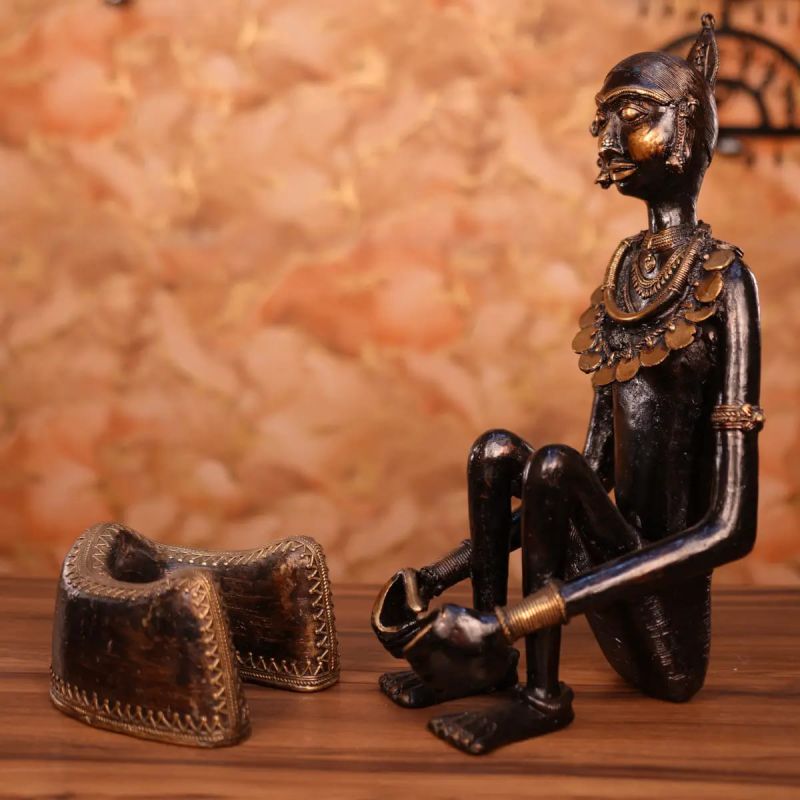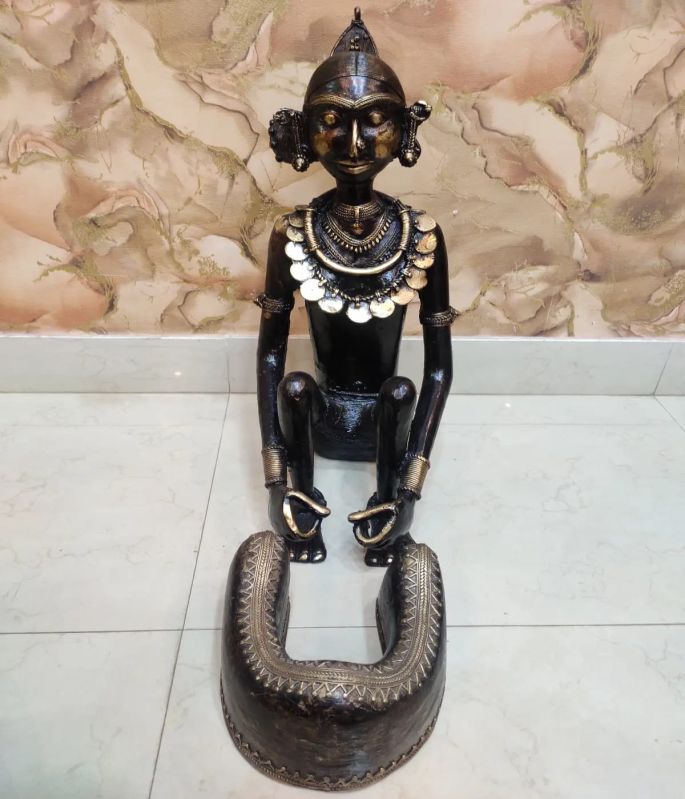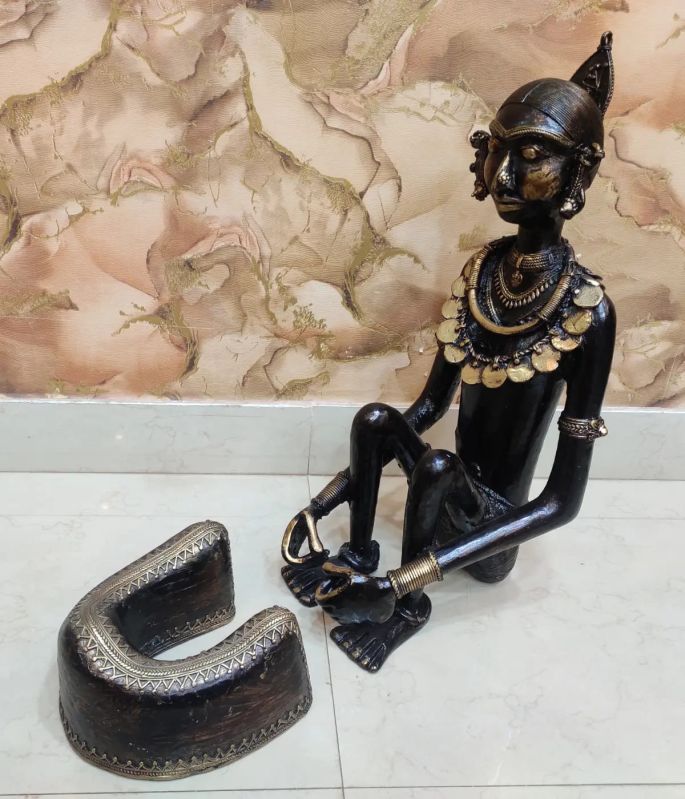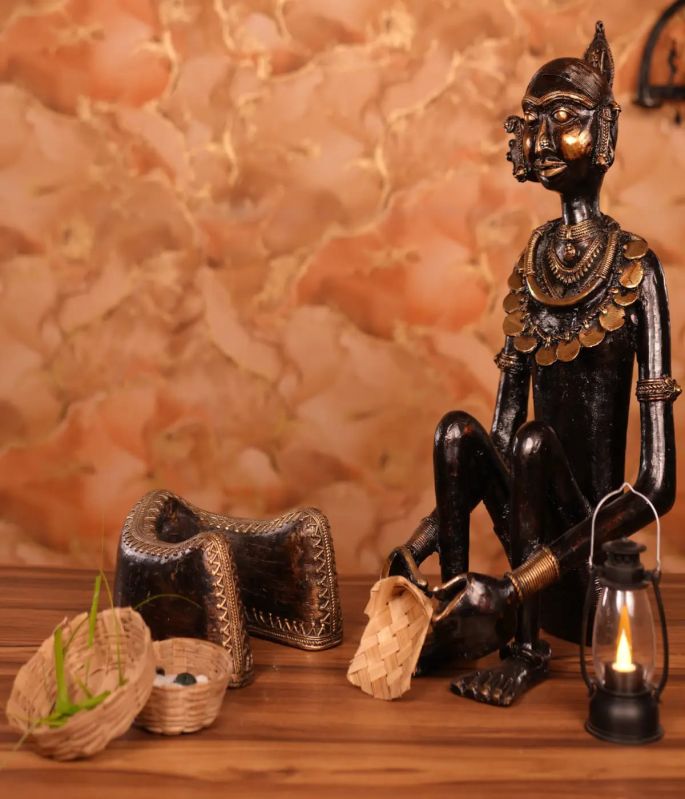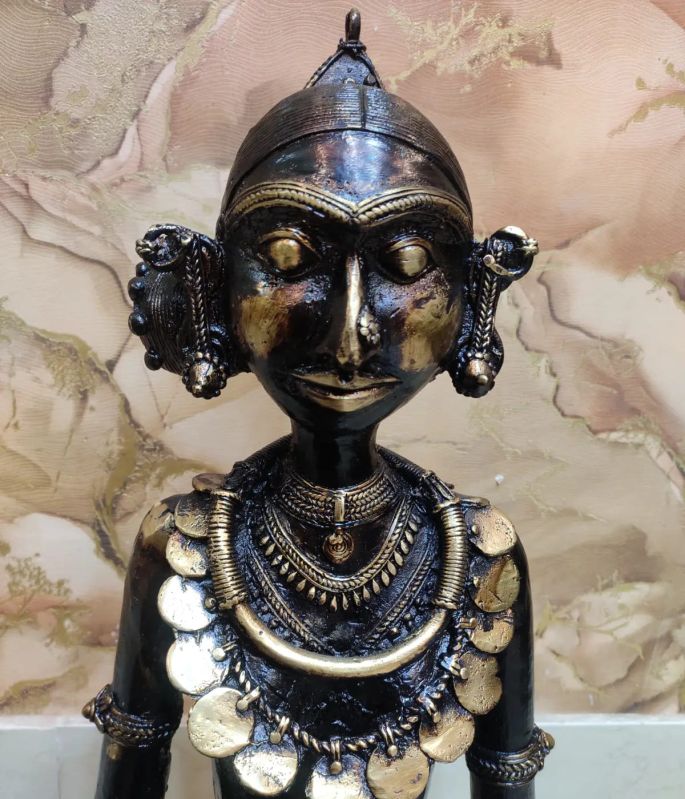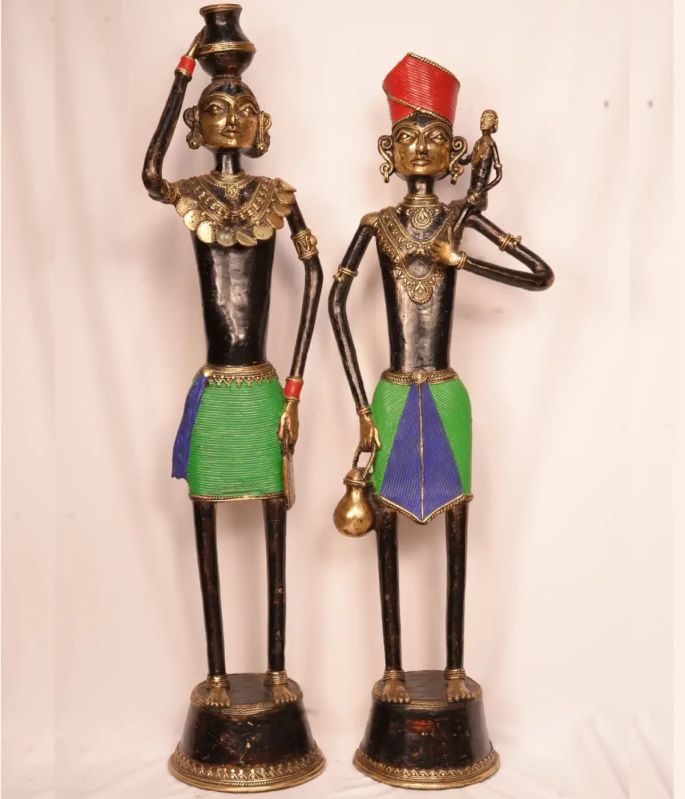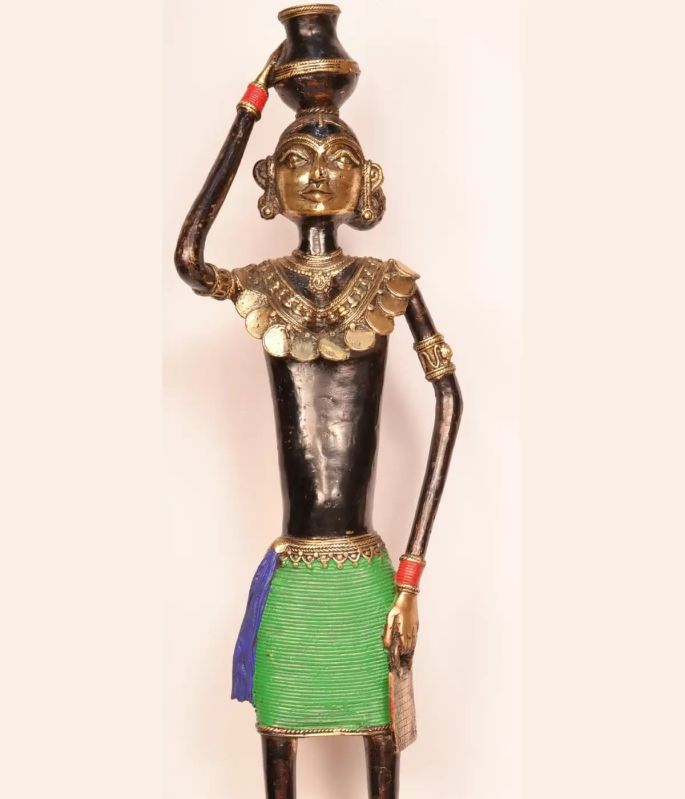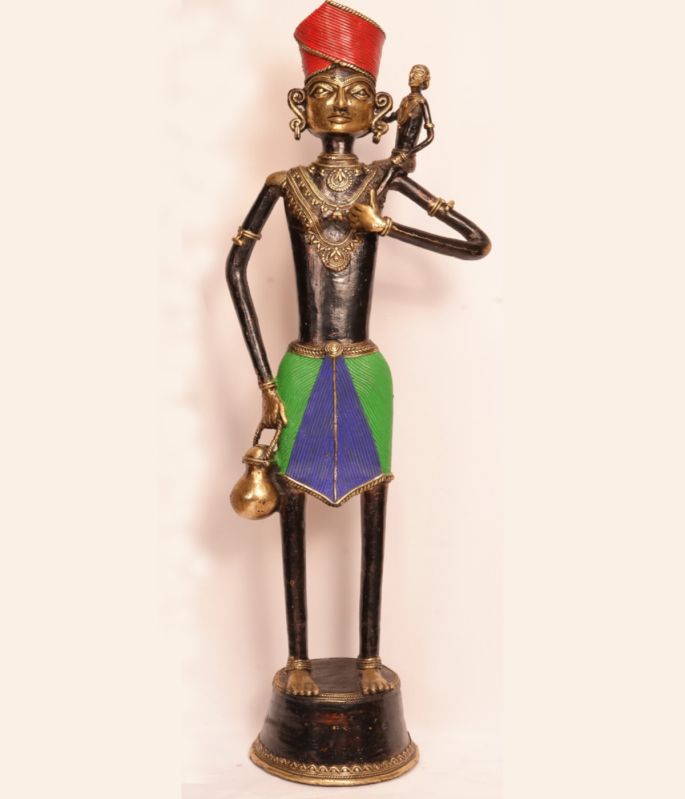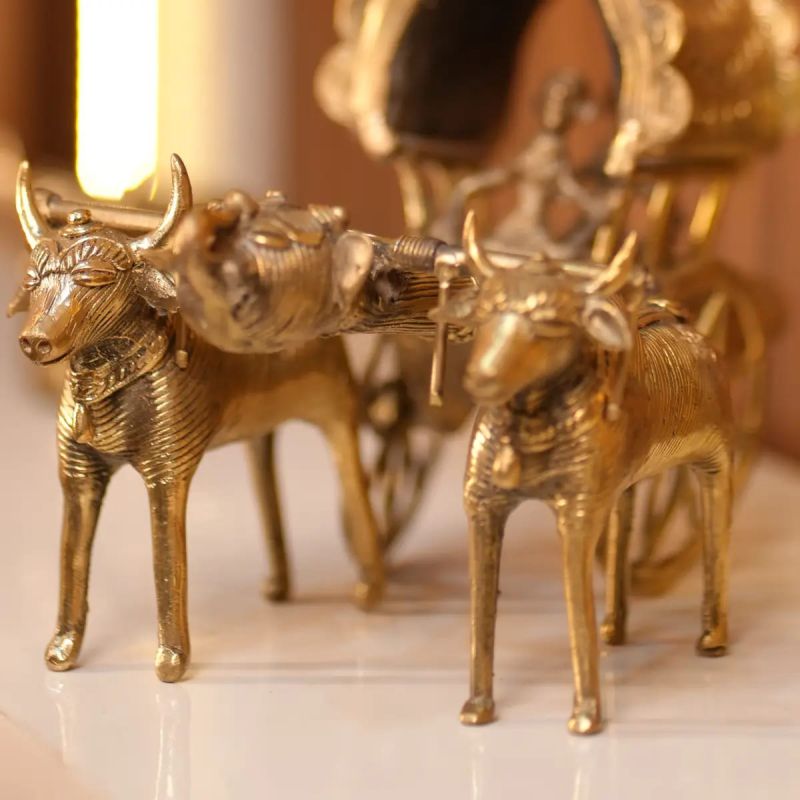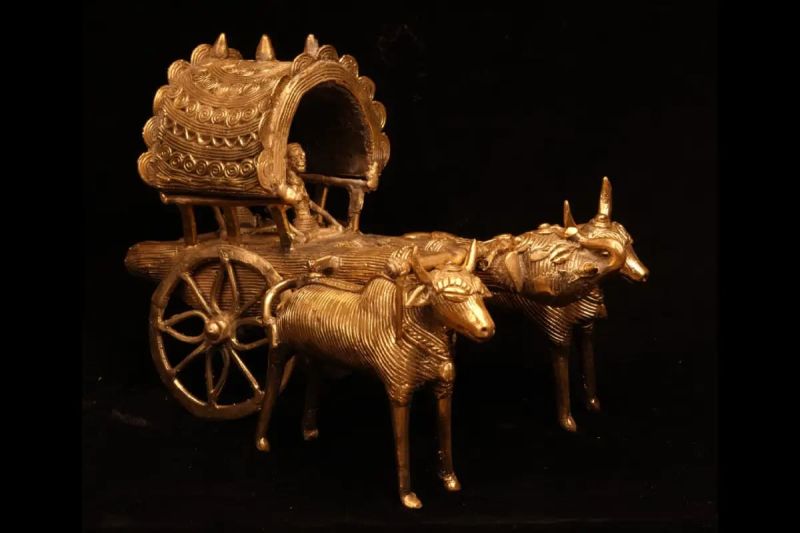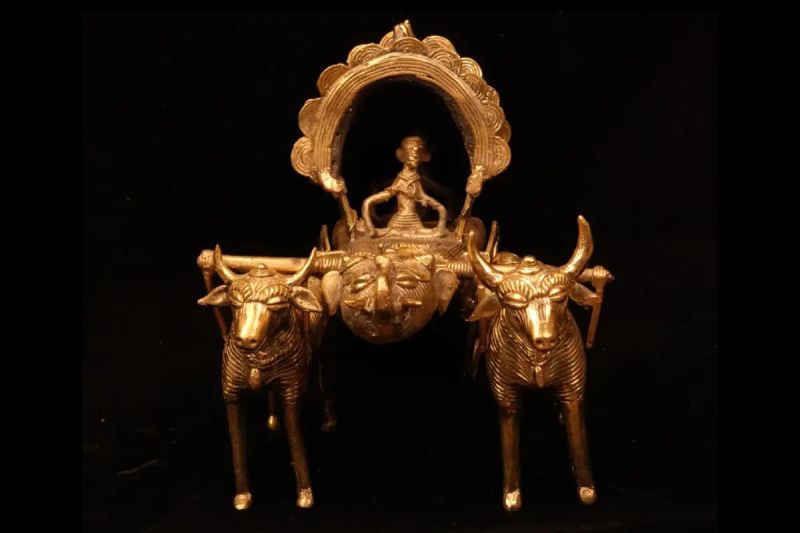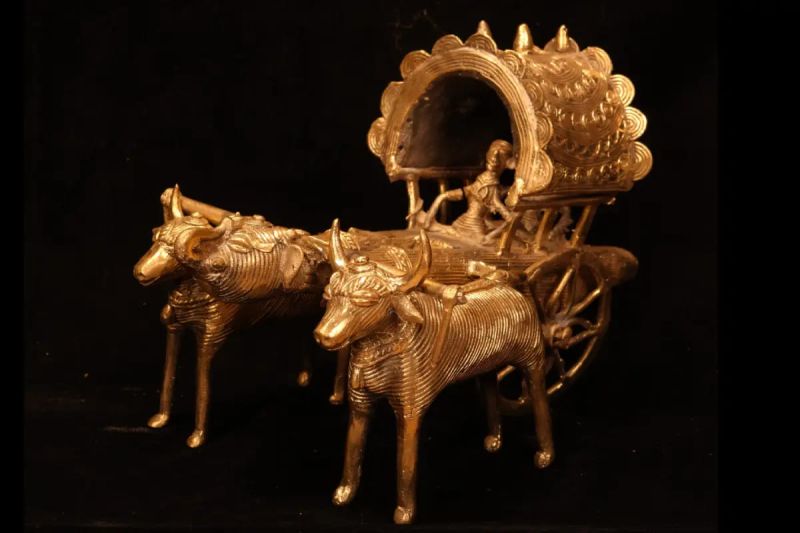Bhilai, Durg, Chhattisgarh
- GST NO. : 22AAFCL6000K1ZV
View Mobile Number
Bell Metal Figurines
Leading Exporters and Wholesaler of Bell Metal Bullock Cart Figurine, Bell Metal Cow and Calf Figurine, Bell Metal Elephant and Peacock Figurine, Bell Metal Hollow Ganesh Figurine, Bell Metal Horse Rider Figurine, Bell Metal Jumping Horse Figurine, Bell Metal Neelambari Pitambar Figurine, Bell Metal Sitting Deer Figurine, Bell Metal Standing Deer Figurine, Bell Metal Standing Horse Figurine, Bell Metal Tribal Couple Figurine, Bell Metal Tribal Female and Chulha Figurine, Bell Metal Vibrant Tribal Couple Figurine and Wrought Iron Bullock Cart Figurine from Durg.
| Business Type | Exporter, Supplier |
| Material | Bell Metal |
| Application | Home Decor, Gifting |
| Style | Dhokra Art |
| Feature | Unique Design, Non Breakable, Corrosion Proof, Good Quality |
| Technics | Hand Crafted |
| Packaging Type | Cartoon Box |
| Type | Bell Metal Figurines |
| Country of Origin | India |
| Weight | 6 KG – 7 KG |
| Utility | Décor |
| Dimensions (LXBXH) Inches | 15.5 X 10 X 6.5 |
“In the modern age of technology, this handcrafted dhokra ox cart can completely make you feel nostalgic and take you back to nature. It enhances the beauty of place where ever it is placed; be it your meditation space , office or home.
The overall design can range from simple and elegant to elaborate and decorative, depending on the artist’s vision.Dhokra is an ancient art form dating back over 4,000 years, practiced in parts of India. It uses the lost-wax casting technique, where intricate designs are made in wax, encased in clay, and then fired. The molten metal replaces the burnt wax, creating a metal replica of the original design.
Dhokra pieces are known for their rustic charm, intricate patterns, and rich cultural heritage.”
Description
The bullock cart, also known as an ox cart, has a long and significant history in ancient India, dating back thousands of years. Here’s a breakdown of its importance:
Early Evidence:
Indus Valley Civilization (3300-1300 BCE): Some of the earliest evidence of bullock carts comes from the Indus Valley Civilization. Terracotta models and cart track impressions found at archaeological sites like Mohenjo-daro and Harappa suggest their use in transportation and trade.
Transportation: Bullock carts were the primary mode of land transport for people and goods throughout ancient India. They were used for short and long journeys, carrying everything from agricultural products to building materials.
Agriculture: Bullock carts were essential for agricultural activities. Farmers used them to transport seeds, manure, and harvested crops. They were also used for plowing fields in some regions.
Social Significance: Bullock carts weren’t just utilitarian vehicles; they also held social significance. Owning a bullock cart was a sign of wealth and status in rural communities. They were sometimes used in wedding processions and other social events.
The bullock cart was a vital part of ancient Indian society, shaping transportation, agriculture, trade, and even social structures. Its enduring presence, even in the modern era, is a testament to its ingenuity and lasting significance.
| Business Type | Exporter, Supplier |
| Material | Bell Metal |
| Application | Home Decor, Gifting |
| Feature | Unique Design, Non Breakable, Good Quality |
| Technics | Hand Crafted |
| Packaging Type | Cartoon Box |
| Type | Bell Metal Figurines |
| Country of Origin | India |
| Art Type | Dhokra Art |
| Utility | Décor , Worship, Keep this At Your Workspace to Attract Abundance |
| Weight | 4 Kg -5 Kg |
| Dimensions (LXBXH) Inches | "COW : 12 X 6.5 X 7.5, CALF : 3.5 X 1.5 X 4" |
“This magnificent art piece depicts the Sacred Cow and its baby calf in a beautiful and symbolic representations of motherhood and the sacredness of cows in Indian culture. Crafted using the ancient lost-wax casting technique, these sculptures showcase the intricate artistry and cultural significance of Dhokra art.
Cow is considered sacred in Hinduism, symbolizing motherhood, abundance, and the Earth. Calf represents new life, innocence, and the nurturing bond between mother and child. Together they symbolize fertility, prosperity, and the continuity of life. Calves frolicking around their mother, representing youthful energy and playfulness.
The Kamdhenu cow, also known as Surabhi, is a divine bovine-goddess depicted in Hinduism as the mother of all cows and a symbol of abundance, prosperity, and generosity. Often portrayed as white with wish-fulfilling abilities, she holds a significant place in Hindu mythology and culture. According to legend, the Kamdhenu cow can grant any desire of her owner. This symbolism signifies the abundance and fulfillment of material and spiritual needs. As the mother of all cows, Kamdhenu is closely associated with the Earth and its fertility. She represents the nourishing and sustaining power of nature and motherhood. In Hinduism, cows are considered sacred animals, symbolizing purity, dharma (righteousness), and ahimsa (non-violence). The Kamdhenu cow embodies these sacred qualities and serves as a reminder of the importance of respecting all living beings.”
Description
Cows are highly revered in Hinduism, considered sacred symbols of life, abundance, and motherhood.
Symbolism:
Mother Earth: The cow represents Prithvi(Earth), the Hindu earth goddess, symbolizing nourishment and sustenance.
Generosity: They provide milk, a vital source of nutrition, without demanding much in return.
Purity: Hindus associate cows with purity, gentleness, and a non-violent way of life.
Divine Associations:
Kamadhenu: A celestial wish-granting cow, Kamadhenu is believed to be the mother of all cows and embodies divine bounty.
Deities: Several Hindu gods and goddesses have connections to cows. Lord Krishna, for instance, is depicted as a cowherd in his youth, and Nandi, the bull, is the mount of Lord Shiva.
Practices and Beliefs:
Veneration: Cows are treated with respect and cared for. Hindus often decorate them and offer them special food during festivals.
Dietary Restrictions: Many Hindus abstain from eating beef due to the cow’s sacred status.
Panchagavya: A mixture of five cow products (milk, curd, ghee, dung, and urine) is used in religious rituals for purification and healing.
The reverence for cows is deeply ingrained in Hindu culture and reflects the religion’s emphasis on ahimsa (non-violence) and respect for all living beings.
| Business Type | Exporter, Supplier |
| Material | Bell Metal |
| Application | Home Decor, Gifting |
| Feature | Unique Design, Non Breakable, Crack Proof, Good Quality |
| Technics | Hand Crafted |
| Packaging Type | Cartoon Box |
| Type | Bell Metal Figurines |
| Country of Origin | India |
| Utility | Décor , Antique |
| Weight | 4.5 KG – 5 KG |
| Dimensions (LXBXH) Inches | 13 X 6 X 13 |
“Dhokra art depicting a peacock perched atop an elephant is a unique and fascinating combination that carries symbolic meaning in several ways. While not as common as individual figures of peacocks or elephants, it holds significance in specific traditions and interpretations.
The peacock symbolizes beauty, pride, and spirituality, often associated with divine messengers or guardians.The elephant represents strength, wisdom, and stability, grounded in the earthly realm.
Their juxtaposition in the artwork can represent the harmonious balance between these seemingly contrasting qualities: spiritual aspirations grounded in reality, or powerful actions guided by beauty and wisdom.
In some cultures, both peacocks and elephants are associated with royalty and power. The peacock symbolizes majesty and regality, while the elephant represents strength and dominance.”
| Business Type | Exporter, Supplier |
| Material | Bell Metal |
| Application | Home Decor, Gifting |
| Style | Dhokra Art |
| Feature | Unique Design, Non Breakable, Corrosion Proof, Good Quality |
| Technics | Handiraft |
| Packaging Type | Cartoon Box |
| Type | Bell Metal Figurines |
| Country of Origin | India |
| Utility | Table top , Décor |
| Weight | 1 Kg – 1.5 Kg |
| Dimensions (LXBXH) Inches | 4 X 4 X 8.5 |
“This masterpiece of Lord Ganesh in a hollow frame pattern is a unique and imaginative work of our profound artists.
Admire the beauty of this art piece and add this your antiques collection by having it in your workspace desk or your home.
Lord Ganesh is considered as the remover of obstacles (Vighneshvara) and the lord of beginnings. He is worshipped before any major undertaking to ensure success and overcome challenges. Elephant head represents strength and intelligence. He is believed to flourish your financials and bring balance in the life of devotees.”
Description
About Lord Ganesha
Ganesha, also spelled Ganesh or Ganapati, is one of the most well-known and worshipped deities in the Hindu pantheon. He is easily identified by his elephant head.
Roles and Symbolism
Remover of Obstacles: Ganesha is perhaps most popularly known as the remover of obstacles, both material and spiritual. He is worshipped at the start of any new venture or undertaking to ensure success.
God of Beginnings: Because of his association with removing obstacles, Ganesha is also seen as the god of beginnings. He is often invoked at the start of religious ceremonies and writings.
Patron of Arts and Sciences: Ganesha is also considered the patron of arts and sciences, and is said to be the scribe who wrote down the Mahabharata, one of the two major Sanskrit epics of ancient India.
Symbol of Wisdom and Intellect: His elephant head is said to symbolize wisdom and intellect, while his large belly symbolizes abundance and prosperity.
Ganesha is typically depicted seated, with a potbellied body and four arms. He often holds a modak, a sweet dumpling that is his favorite food. One of his tusks is usually broken, which represents his willingness to sacrifice in order to overcome obstacles. He is often depicted riding a mouse or a rat, which symbolizes his ability to control even the smallest of things.
| Business Type | Exporter, Supplier |
| Material | Bell Metal |
| Application | Home Decor |
| Packaging Type | Cartoon Box |
| Type | Bell Metal Figurines |
| Country of Origin | India |
| Utility | Décor , Table Top |
| Weight | 5 KG – 6 KG |
| Dimensions (LXBXH) Inches | 14.5 x 7 x 15 |
| Art Type | Dhokra Art |
“The horse rider is a common motif in Dhokra art, symbolizing strength, power, and freedom. These figures often depict warriors, hunters, or deities riding horseback, and are often adorned with intricate patterns and designs.
Dhokra horse riders come in a variety of styles, ranging from simple and stylized to more elaborate and detailed.
The horse rider motif holds cultural significance in many tribal communities in India, representing various deities and mythological figures.
Description
Dhokra art is a unique and ancient metal craft art form practiced by the indigenous communities of Odisha and Chhattisgarh in India. It is believed to be over 4,000 years old, making it one of the earliest forms of metal casting. The name “Dhokra” comes from the Dhokra Damar tribe, who are traditionally known for their skills in metalworking.
Dhokra art is created using the lost-wax casting technique. In this process, bees wax is used to create a mold of the desired design. The wax mold is then encased in clay and fired. The heat melts away the wax, leaving a cavity in the clay in the shape of the original design. Dhokra art is known for its intricate geometric patterns, animal figures, and human forms. The craftsmen use simple tools and traditional methods to create these beautiful and functional objects. Common dhokra art pieces include figurines, jewelry, utensils, and decorative items.
| Business Type | Exporter, Supplier |
| Material | Bell Metal |
| Style | Antique |
| Feature | Corrosion Proof, Non Breakable, Unique Design, Good Quality |
| Packaging Type | Cartoon Box |
| Type | Horse Figurine |
| Country of Origin | India |
| Utility | Décor , Table Top |
| Weight | 4.5 KG – 5 KG |
| Dimensions (LXBXH) Inches | 10 X 3.5 X 12 |
“This artpiece depicts the exquisite details of a horse which is jumping at its speed. The intricate details are crafted with precision by the artists which makes it look no less than a realistic one.
As per Vastu-shastra(science of architecture), a horse is auspicious, powerful, resilient, and courageous. Running horses symbolize speed and a fast-paced life full of milestones like career, marriage, children, fitness, education, or personal development. Figurines of horse can invite positivity to life.”
Description
Jumping horses hold a wealth of symbolism across cultures, often representing positive attributes and aspirations.
Power and Dynamism: The powerful spring of a jumping horse embodies energy, dynamism, and taking action towards your dreams. It represents the drive to push yourself beyond your limits and achieve success.
Ambition and Aspiration: The upward motion of the jump signifies ambition and setting your sights high. It encourages you to reach for your goals and not be afraid to take risks.
Victory and Triumph: A successful jump can symbolize victory, triumph, and achieving your objectives. It represents overcoming challenges and emerging stronger on the other side.
Transformation and Growth: The act of leaping can also signify personal transformation and growth. The horse is literally transitioning to a new state, which can represent your own journey of self-discovery and positive change.
Spiritual Connection: In some cultures, the horse is seen as a spiritual guide or messenger. A jumping horse might symbolize a message from your inner self, urging you to take a leap of faith and trust your intuition.
A horse leaping forward signifies moving confidently towards your goals. A jump upwards emphasizes reaching for new heights.
Horse teaches us to :
Resilience and Overcoming Fear.
Live in Harmony with Nature.
Respect for Power.
Always Alert.
Focus on just Target.
Partnership and Communication.
| Business Type | Exporter, Supplier |
| Material | Bell Metal |
| Application | Home Decor, Gifting |
| Style | Dhokra Art |
| Feature | Unique Design, Non Breakable, Corrosion Proof, Good Quality |
| Technics | Handicraft |
| Packaging Type | Cartoon Box |
| Type | Bell Metal Figurines |
| Country of Origin | India |
| Utility | Décor , Antique |
| Dimensions (LXBXH) Inches | 13.5 X 6 X 21.5 |
| Weight | 2-3 Kg |
“Neelambar means Blue, Pitambar means Yellow in Hinduism. The tribal couple depicts the joy and blossom which is celebrated and expierienced during vivid occasions in INDIA.
Yellow, the color of sunshine and warmth, carries a potent mix of positive and complex spiritual meanings across various cultures and belief systems. Blue’s calming nature often connects it to feelings of inner peace, serenity, and emotional balance. It evokes a sense of calm waters, clear skies, and quiet reflection.
A Vibrant Tapestry: Exploring Tribal Festivals and Dances.Tribal festivals and dances are an integral part of the cultural fabric of many societies worldwide. They serve as vibrant expressions of tradition, spirituality, and community, offering a glimpse into the unique customs and heritage of diverse tribal groups.
These celebrations often erupt in a kaleidoscope of colors, energetic movements, and captivating music, weaving together storytelling, rituals, and social interactions. Each dance and festival holds a special significance, reflecting the values, beliefs, and history of its specific community.
By exploring the rich tapestry of tribal festivals and dances, we gain a deeper understanding of human diversity, cultural expressions, and the profound connection between communities and their environments.”
Description
The tribes of Bastar region of INDIA are known for their unique and distinctive tribal culture and heritage. Each tribal group in Bastar has their own distinct culture and enjoys their own unique traditional living styles, each tribe here will have its own diverse dialect. They differ from other tribes in their costumes, eating habits, customs and tradition.
Madai is one of the many popular festivals of Chhattisgarh, the festivals are celebrated from the months of December to March and towards from one place of the state to the other. Their colorful attire, their smile, their welcoming face, their strength and patience and the dense forests of Bastar.
The Madai Mela in Bastar begins when during agand mahina, ‘dhaan katai’ is complete (rice harvest). The harvesting season ends and soon after the madai mela begins. After a good harvest it is a form of thanking the gods and goddesses. It is also held to dispel the yearlong struggles, efforts and tiredness through music, dance, interacting with the community.
| Business Type | Exporter, Supplier |
| Material | Bell Metal |
| Application | Home Decor, Gifting |
| Feature | Unique Design, Shiny Look, Non Breakable, Good Quality |
| Packaging Type | Cartoon Box |
| Type | Bell Metal Figurines |
| Country of Origin | India |
| Utility | Décor , Antique |
| Weight | 3 KG – 4 KG |
| Dimensions (LXBXH) Inches | 8.5 X 3.25 X 9.5 |
| Art Type | Dhokra Type |
| Theme | Animal |
“Dhokra deer art, like its counterpart featuring horses, embodies the rich cultural heritage of India’s tribal communities of INDIA. These breathtaking sculptures showcase the age-old lost-wax casting technique, also known as bell metal casting, in a way that captures the essence of the graceful deer.
Each dhokra deer is a one-of-a-kind piece, reflecting the artisan’s individual style and subtle variations in the casting process. This adds to the charm and authenticity of the art form.
Deer hold significant symbolism in Indian culture, representing gentleness, grace, agility, and peace. Dhokra deer sculptures embody these qualities, making them popular choices for home decor and gifting.
The deer often depict graceful postures, alert expressions, and sometimes even playful movements.
In some cultures, deer are seen as spirit guides, offering protection and guidance on life’s journey. Seeing a deer might be interpreted as a sign of positive change or encouragement to follow your intuition.”
Description
Deer hold a fascinating and multifaceted place in Hinduism, appearing in mythology, symbolism, and even practical applications. Here’s a breakdown of their significance:
Symbolism:
Grace and Gentleness: The deer’s movements are known for their elegance and quiet power. They represent approaching life with grace, kindness, and compassion.
Intuition and Sensitivity: With their keen senses, deer are seen as highly intuitive creatures. They encourage you to trust your inner voice and navigate life with awareness.
Vulnerability and Innocence: The gentle nature of deer signifies innocence and vulnerability. They might be a reminder to embrace your own sensitivity or protect your inner child.
Regeneration and Renewal: Deer antlers fall off and regrow each year, symbolizing rebirth and the cyclical nature of life. They might represent personal transformation or new beginnings.
Alertness and Adaptability: A deer’s sharp senses and ability to flee danger make them symbols of alertness and adaptability. They might encourage you to stay aware of your surroundings and adjust to changing circumstances.
Things to learn from Deer:
Embrace your gentle nature.
Pay attention to your intuition.
Navigate challenges with grace.
Be open to new beginnings.
Stay alert and adaptable.
| Business Type | Exporter, Supplier |
| Material | Bell Metal |
| Application | Home Decor, Gifting |
| Style | Dhokra Art |
| Feature | Unique Design, Shiny Look, Corrosion Proof, Good Quality |
| Technics | Hand Crafted |
| Packaging Type | Cartoon Box |
| Type | Bell Metal Figurines |
| Country of Origin | India |
| Utility | Décor , Antique |
| Weight | 1.5 KG |
| Dimensions (LXBXH) Inches | 10 X 3 X 14 |
| Theme | Animal |
“Dhokra deer art, like its counterpart featuring horses, embodies the rich cultural heritage of India’s tribal communities of INDIA.These breathtaking sculptures showcase the age-old lost-wax casting technique, also known as bell metal casting, in a way that captures the essence of the graceful deer.
Each dhokra deer is a one-of-a-kind piece, reflecting the artisan’s individual style and subtle variations in the casting process. This adds to the charm and authenticity of the art form.
Deer hold significant symbolism in Indian culture, representing gentleness, grace, agility, and peace. Dhokra deer sculptures embody these qualities, making them popular choices for home decor and gifting.
The deer often depict graceful postures, alert expressions, and sometimes even playful movements.
In some cultures, deer are seen as spirit guides, offering protection and guidance on life’s journey. Seeing a deer might be interpreted as a sign of positive change or encouragement to follow your intuition.”
Description
Deer hold a fascinating and multifaceted place in Hinduism, appearing in mythology, symbolism, and even practical applications. Here’s a breakdown of their significance:
Symbolism:
Grace and Gentleness: The deer’s movements are known for their elegance and quiet power. They represent approaching life with grace, kindness, and compassion.
Intuition and Sensitivity: With their keen senses, deer are seen as highly intuitive creatures. They encourage you to trust your inner voice and navigate life with awareness.
Vulnerability and Innocence: The gentle nature of deer signifies innocence and vulnerability. They might be a reminder to embrace your own sensitivity or protect your inner child.
Regeneration and Renewal: Deer antlers fall off and regrow each year, symbolizing rebirth and the cyclical nature of life. They might represent personal transformation or new beginnings.
Alertness and Adaptability: A deer’s sharp senses and ability to flee danger make them symbols of alertness and adaptability. They might encourage you to stay aware of your surroundings and adjust to changing circumstances.
Things to learn from Deer:
Embrace your gentle nature.
Pay attention to your intuition.
Navigate challenges with grace.
Be open to new beginnings.
Stay alert and adaptable.
| Business Type | Exporter, Supplier |
| Material | Bell Metal |
| Application | Home Decor, Gifting |
| Style | Dhokra Art |
| Technics | Hand Crafted |
| Packaging Type | Cartoon Box |
| Type | Bell Metal Figurines |
| Country of Origin | India |
| Utility | Décor , Antique |
| Dimensions (LXBXH) Inches | 7.5 X 3 X 13 |
| Weight | 2.5 KG |
“Dhokra horse art is a captivating blend of ancient tradition and artistic expression. It embodies the rich cultural heritage of tribal communities in India. Their skilled artisans handcraft these stunning sculptures using the age-old lost-wax casting technique, also known as bell metal casting.
Each dhokra horse is a one-of-a-kind piece, reflecting the artisan’s individual style and subtle variations in the casting process. This adds to the charm and authenticity of the art form.
Horses hold significant symbolism in Indian culture, representing power, nobility, loyalty, and freedom. Dhokra horses embody these qualities, making them popular choices for home decor and gifting.
The natural texture of the bell metal, combined with the intricate details and geometric patterns, creates a visually striking aesthetic. The horses often depict dynamic postures, graceful movements, and expressive features.
In some cultures, horses are seen as guides or companions on the spiritual journey. They symbolize the journey itself, reminding us to move forward with courage and trust the process.”
Description
Horses hold a significant place in Hinduism, both literally and figuratively. Here’s a breakdown of their importance:
Symbolism:
Strength and Power: Horses are seen as powerful creatures, symbolizing royalty, nobility, and martial prowess.
Loyalty and Respect: The bond between a horse and rider is highly valued, representing loyalty, respect, and service.
Partnership and Trust: Horses have a long history of working alongside humans. Their connection with riders signifies the importance of trust, communication, and building strong partnerships.
Intuition and Connection: Some believe horses are sensitive to human emotions and can be spirit guides or messengers. They might encourage you to trust your intuition and connect with your inner self.
Knowledge: Hayagriva, an avatar of Vishnu, has a horse’s head. He is associated with knowledge, wisdom, and eloquence.
Sun God’s Chariot: The sun god Surya is depicted riding a chariot pulled by seven swift horses, representing the passage of time and the sun’s rays.
Vastu Shastra, the ancient Indian architectural system, recommends incorporating horses for good luck.
Horses can be powerful spiritual symbols, and their meaning can vary depending on your personal experiences and beliefs.
| Business Type | Exporter, Supplier |
| Material | Bell Metal |
| Application | Home Decor, Gifting |
| Style | Dhokra Art |
| Feature | Unique Design, Non Breakable, Corrosion Proof, Good Quality |
| Technics | Hand Knitted |
| Packaging Type | Cartoon Box |
| Type | Bell Metal Figurines |
| Country of Origin | India |
| Utility | Décor , Antique |
| Weight | "Male: 14kg –15 Kg, Female: 13kg – 14 Kg, Total – 27kg – 28 Kg" |
| Dimensions (LXBXH) Inches | "Male : 8 X 8 X 38, Female : 8 X 8 X 38" |
“This wonderstruck piece of tribal couple is crafted in Dhokra art, the immense intricate details are strong enough to mesmerize your thoughts. One can easily admire the beauty of this artpiece for hours as they just cant stop looking at this work of our skilled artists !!
The artists have depicted the details of jewelry worn by these people, their lifestyle and the clothing pattern, the hairstyle the headgears along with the accessories.
The tribe is known as “”MURIA”” Native to India, the Muria tribe is mostly found in the Central INDIA. The Muria people have a strong cultural history and adhere to their own customs, rituals, and practices. They have a unique system of social structure, and an elder council oversees each of their settlements.”
Bell Metal Tribal Couple Figurine quantity
Description
The Muria tribe, residing in the Bastar region of Chhattisgarh, India, are known for their vibrant and symbolic ornaments. These ornaments are more than just decorations, they hold cultural and spiritual significance.
Necklaces: Made from beads, shells, seeds, and even metal, necklaces come in various lengths and styles. They often depict geometric patterns, animal figures, and nature motifs.
Ear ornaments: Muria women wear large, circular earrings made of silver or brass. Sometimes they are decorated with beads or bells.
Head ornaments: Head ornaments are significant for both men and women. Women wear headpieces made of beads, shells, and feathers during festivals and ceremonies. Men wear caps made of leaves or cloth.
Armlets and bangles: Made from glass, metal, and wood, armlets and bangles are worn by both men and women. They are believed to ward off evil spirits and bring good luck.
Nose rings and lip plugs: While less common today, nose rings and lip plugs were traditionally worn by Muria women. They were made of silver or brass and could be quite large.
The materials used in Muria ornaments are often locally sourced and have symbolic meanings. For example, cowrie shells represent fertility, while peacock feathers represent beauty. The ornaments are not just beautiful, but they also tell stories about the wearer’s identity, status, and beliefs.
| Business Type | Exporter, Supplier |
| Material | Bell Metal |
| Application | Home Decor |
| Style | Dhokra Art |
| Feature | Unique Design, Non Breakable, Corrosion Proof, Good Quality |
| Technics | Hand Crafted |
| Packaging Type | Cartoon Box |
| Type | Bell Metal Figurines |
| Country of Origin | India |
| Utility | Décor , Antique |
| Weight | 16 KG – 17 KG (Both) |
| Dimensions (LXBXH) Inches | Female-9 X 9 X 21, Chulha-8 x 6.5 x 4.5 |
“Chulha Tribal Woman: A Symbol of Resilience and Tradition
Chulha: The chulha, a traditional clay oven used for cooking, represents the heart of the home and the core responsibility of women in many tribal communities. It signifies nurturing, sustenance, and the act of providing for families.The woman depicts strength, resilience, and the embodiment of cultural traditions. She represents hard work, dedication, and the spirit of community.She often wears traditional ornaments and clothing, reflecting the specific tribal community and region.
The intricate details and rustic beauty of dhokra art further add to the symbolism, highlighting the artistic heritage and skill passed down through generations.”
Description
Rural women in India possess immense strength in several ways:
Resilience in the Face of Hardship: Their lives were often marked by hard work, limited resources, and societal barriers. Yet, they persevere, managing households, contributing to agriculture, and caring for their families.
Economic Powerhouse: Despite land ownership limitations, they are crucial to the rural economy. They manage livestock, work in agricultural fields, and contribute significantly to animal husbandry and dairying.
Community Builders: They play a central role in shaping rural communities. They are often the caregivers, educators within families, and preservers of tradition and culture.
Entrepreneurial Spirit: With limited means, many embark on small businesses, participating in self-help groups and microfinance initiatives. This drive to be self-sufficient and contribute to the family income is a testament to their resourcefulness.
Agents of Change: They increasingly advocated for their rights and challenging traditional norms. Their participation in self-help groups and social initiatives empowers them to fight for better education, healthcare, and social justice in their communities.
| Business Type | Exporter, Supplier |
| Material | Bell Metal |
| Application | Home Decor, Gifting |
| Style | Dhokra Art |
| Feature | Unique Design, Non Breakable, Corrosion Proof, Good Quality |
| Technics | Handicraft |
| Pattern | Carved |
| Packaging Type | Cartoon Box |
| Type | Bell Metal Figurines |
| Country of Origin | India |
| Utility | Décor , Antique |
| Weight | 15 Kg – 16 Kg (both) |
| Dimensions (LXBXH) Inches | "Male : 9 X 6 X 29, Female : 7 X 7 X 30" |
“Celebrating Tribal Life in Vivid Colors
Dhokra art, known for its captivating use of lost-wax casting and intricate details, brings tribal life and traditions to life. When color is incorporated into this ancient art form, the vibrancy and symbolism reach new heights.
Tribal pairs often represent unity, partnership, and the interconnectedness within a community. They depict couples, friends, or even deities, highlighting the importance of collaboration and social bonds.
The use of vibrant colors adds a celebratory and joyful element to the artwork. It reflects the festive spirit of tribal communities and their connection to nature.
The specific colors, patterns, and motifs used in the artwork often hold cultural significance, reflecting the traditions and beliefs of the specific tribal community.”
Description
The Muria and Maria tribes are known for their vibrant culture and traditions. They have a strong connection to their land and ancestors. The Maria people are primarily dependent on agriculture for their livelihood. They cultivate rice, millet, and other crops using traditional methods. The Marias celebrate various festivals throughout the year, such as “Hareli” and “Madia”, which are associated with agriculture and harvesting. These festivals are vibrant occasions marked by music, dance, and community feasts. The Maria tribe has a strong social structure with village councils playing a vital role in decision-making. They practice animism, a belief system where spirits are believed to reside in all living things. They also have a strong sense of community, where everyone contributes to the well-being of the group.
Women play a crucial role in maintaining the social fabric of the tribes. They participate in community activities, raise children together, and contribute to agricultural work. Tribal women are known for their artistic skills. They create beautiful beadwork, embroidery, and decorate their homes with intricate designs.
Maria women adorn themselves with beautiful ornaments made from natural materials like seashells, bones, seeds, and wood. These ornaments hold cultural significance and often act as symbols of social status, marital status, and wealth. Made from threaded seashells, beads, and colored threads. Haar(Necklace)signify social status and marital status with married women typically wearing more elaborate necklaces. Made from flowers, feathers, and beads, Keshar add a touch of color and vibrancy to hairstyles. Made from metal or brass, Ghungroo(Anklets) produce a rhythmic sound when women walk or dance. They are seen as decorative as well as a way to ward off evil spirits.
| Business Type | Exporter, Supplier |
| Material | Wrought Iron |
| Color | Golden |
| Usage | Interior Decor, Gifting |
| Size | Small |
| Style | Antique |
| Pattern | Carved |
| Packaging Type | Carton Box |
| Country of Origin | India |
| Utility | Décor |
| Weight | 2 KG – 2.5 KG |
| Dimensions (LXBXH) Inches | 10 X 6.5 X 7.5 |
| Technique | Handicraft |
“In the modern age of technology, this handcrafted dhokra ox cart can completely make you feel nostalgic and take you back to nature. It enhances the beauty of place where ever it is placed; be it your meditation space , office or home.
The overall design can range from simple and elegant to elaborate and decorative, depending on the artist’s vision.Dhokra is an ancient art form dating back over 4,000 years, practiced in parts of India. It uses the lost-wax casting technique, where intricate designs are made in wax, encased in clay, and then fired. The molten metal replaces the burnt wax, creating a metal replica of the original design.
Dhokra pieces are known for their rustic charm, intricate patterns, and rich cultural heritage.”
Description
The bullock cart, also known as an ox cart, has a long and significant history in ancient India, dating back thousands of years. Here’s a breakdown of its importance:
Early Evidence:
Indus Valley Civilization (3300-1300 BCE): Some of the earliest evidence of bullock carts comes from the Indus Valley Civilization. Terracotta models and cart track impressions found at archaeological sites like Mohenjo-daro and Harappa suggest their use in transportation and trade.
Transportation: Bullock carts were the primary mode of land transport for people and goods throughout ancient India. They were used for short and long journeys, carrying everything from agricultural products to building materials.
Agriculture: Bullock carts were essential for agricultural activities. Farmers used them to transport seeds, manure, and harvested crops. They were also used for plowing fields in some regions.
Social Significance: Bullock carts weren’t just utilitarian vehicles; they also held social significance. Owning a bullock cart was a sign of wealth and status in rural communities. They were sometimes used in wedding processions and other social events.
The bullock cart was a vital part of ancient Indian society, shaping transportation, agriculture, trade, and even social structures. Its enduring presence, even in the modern era, is a testament to its ingenuity and lasting significance.


